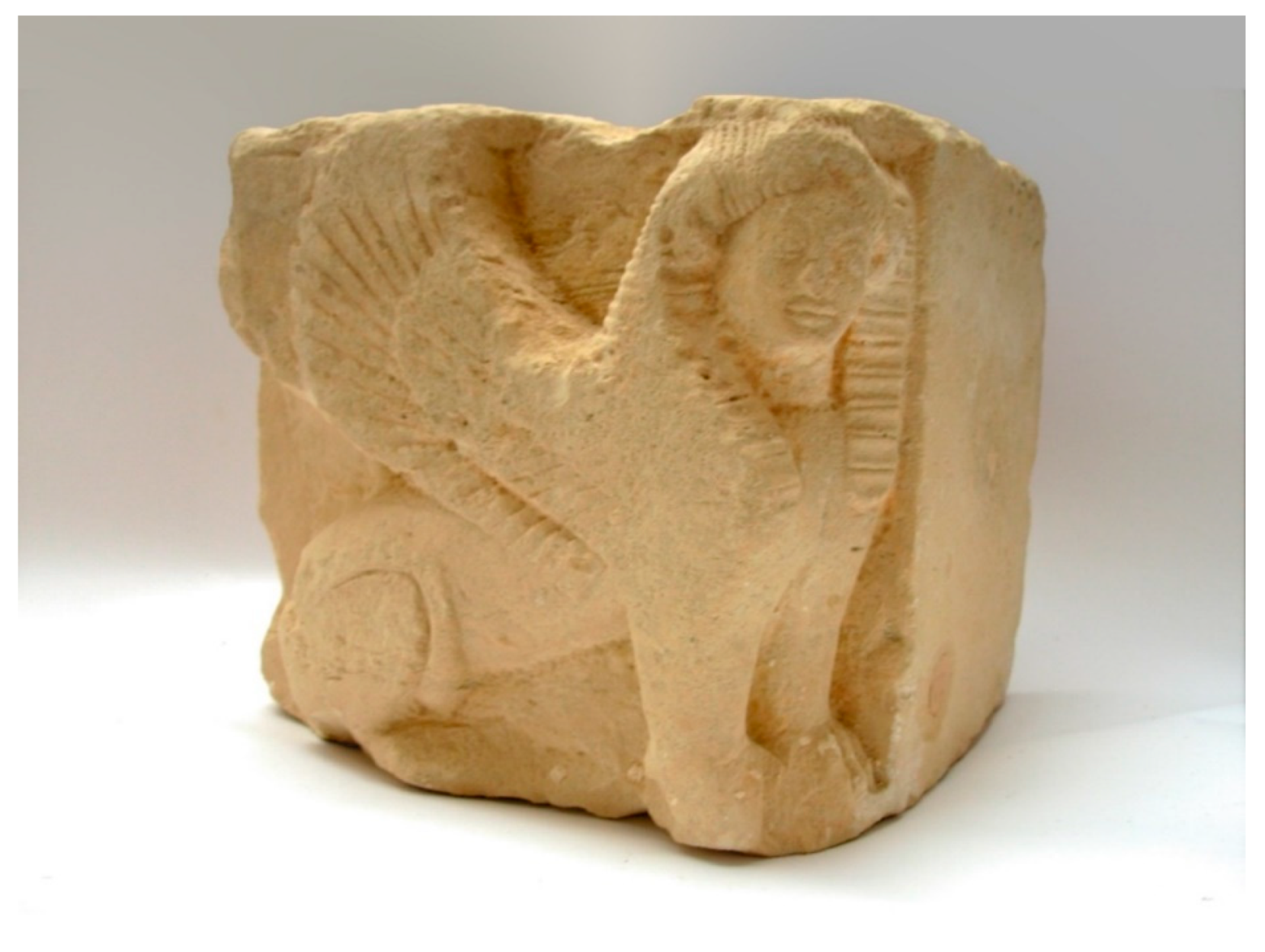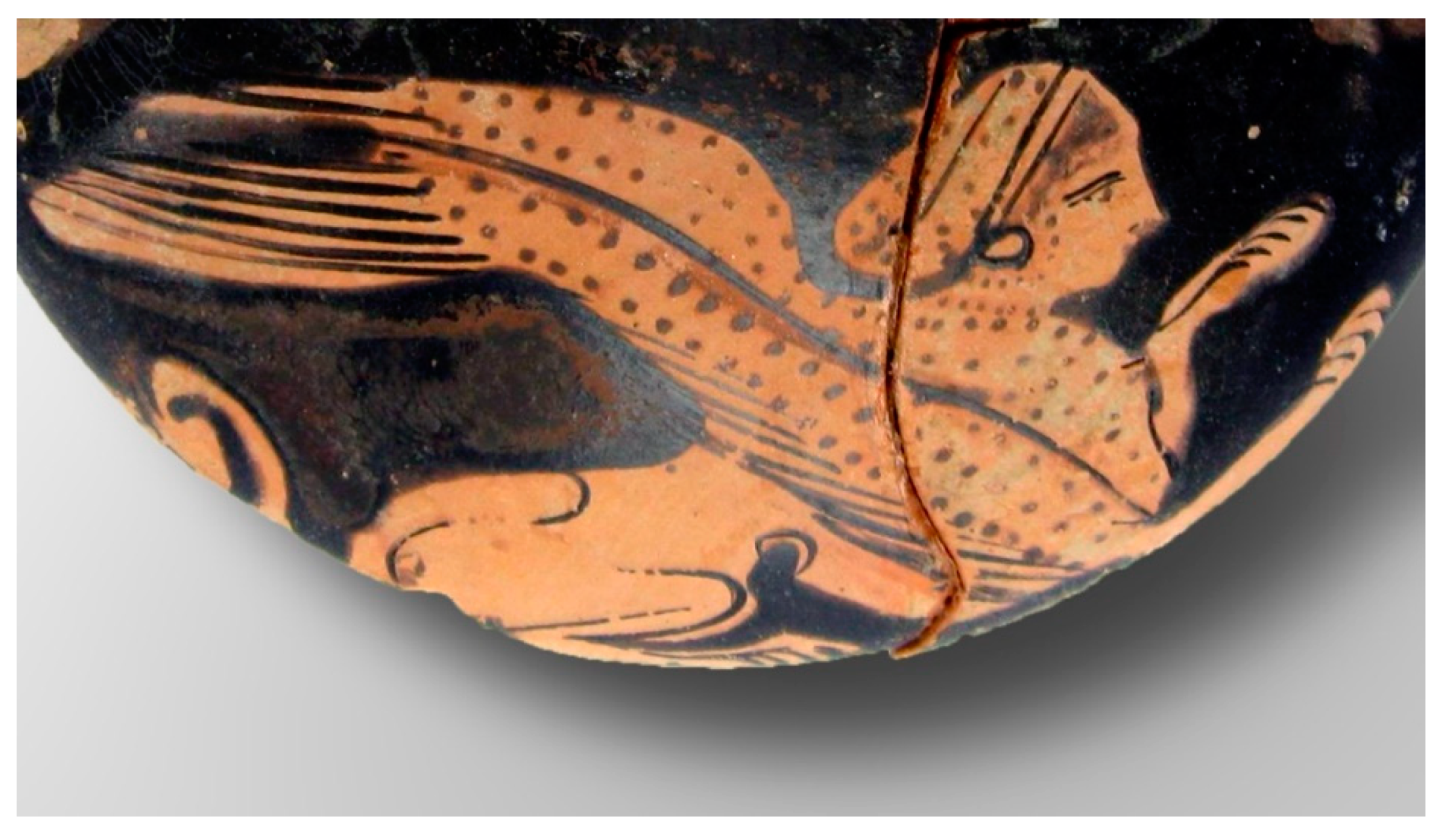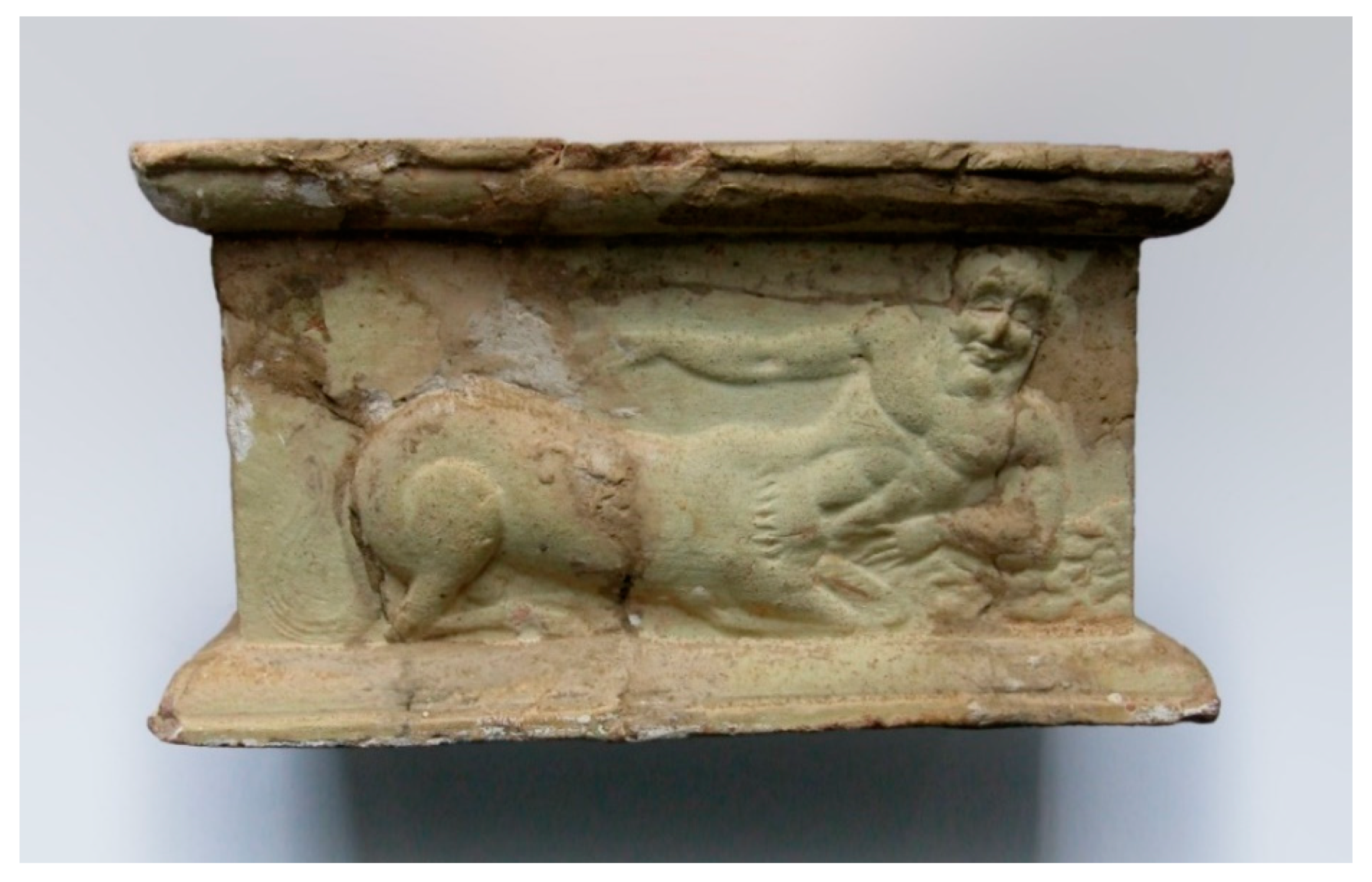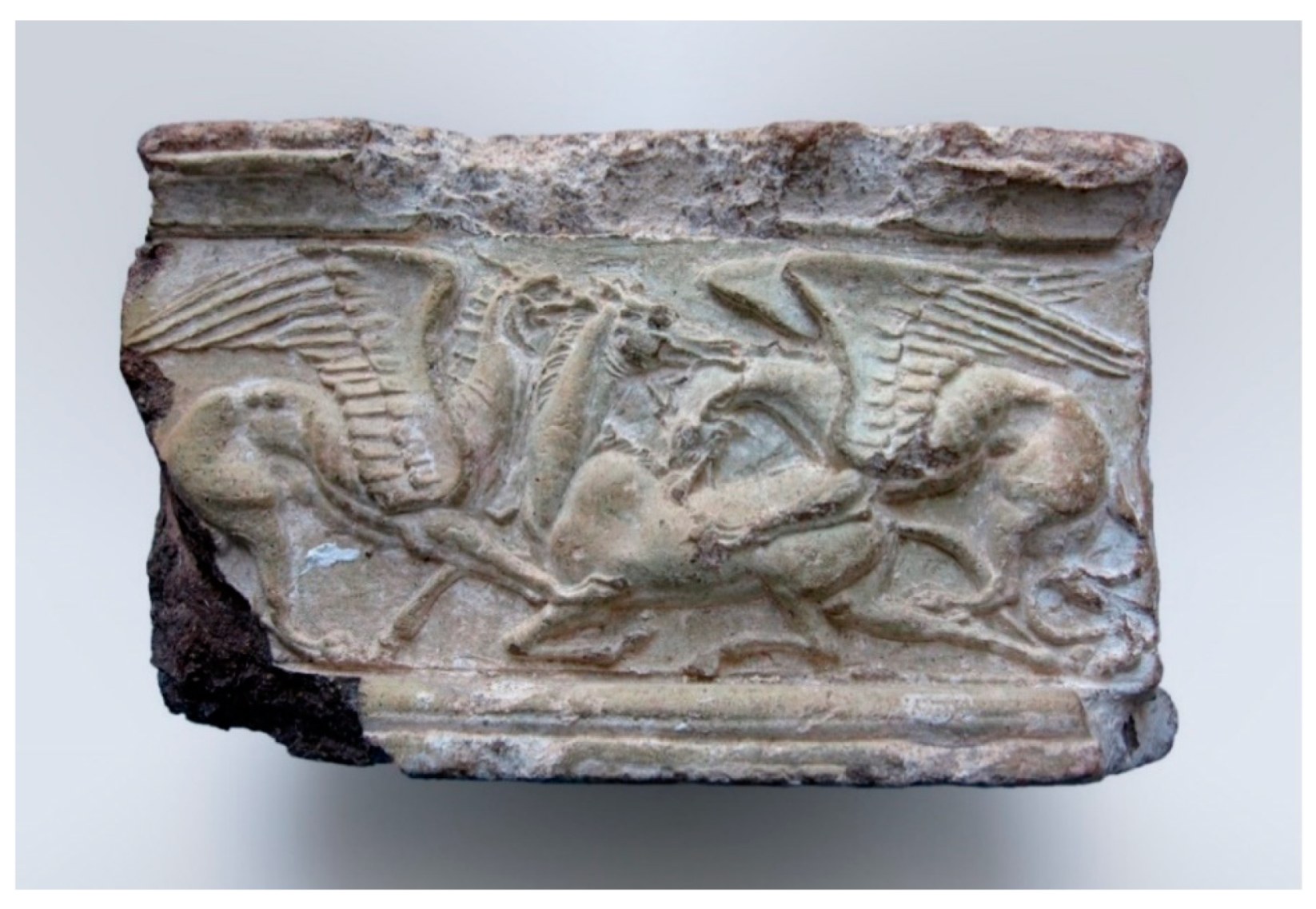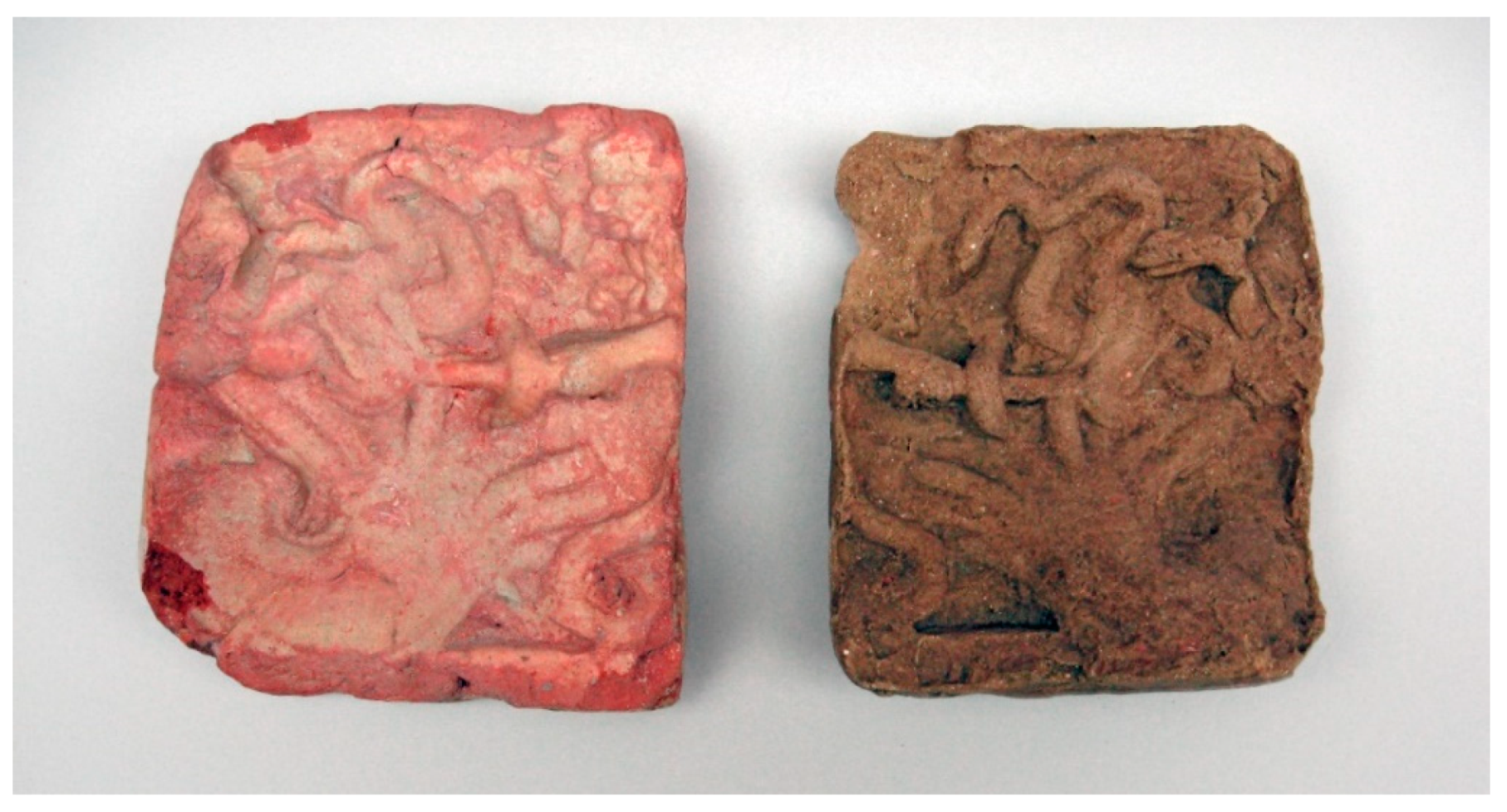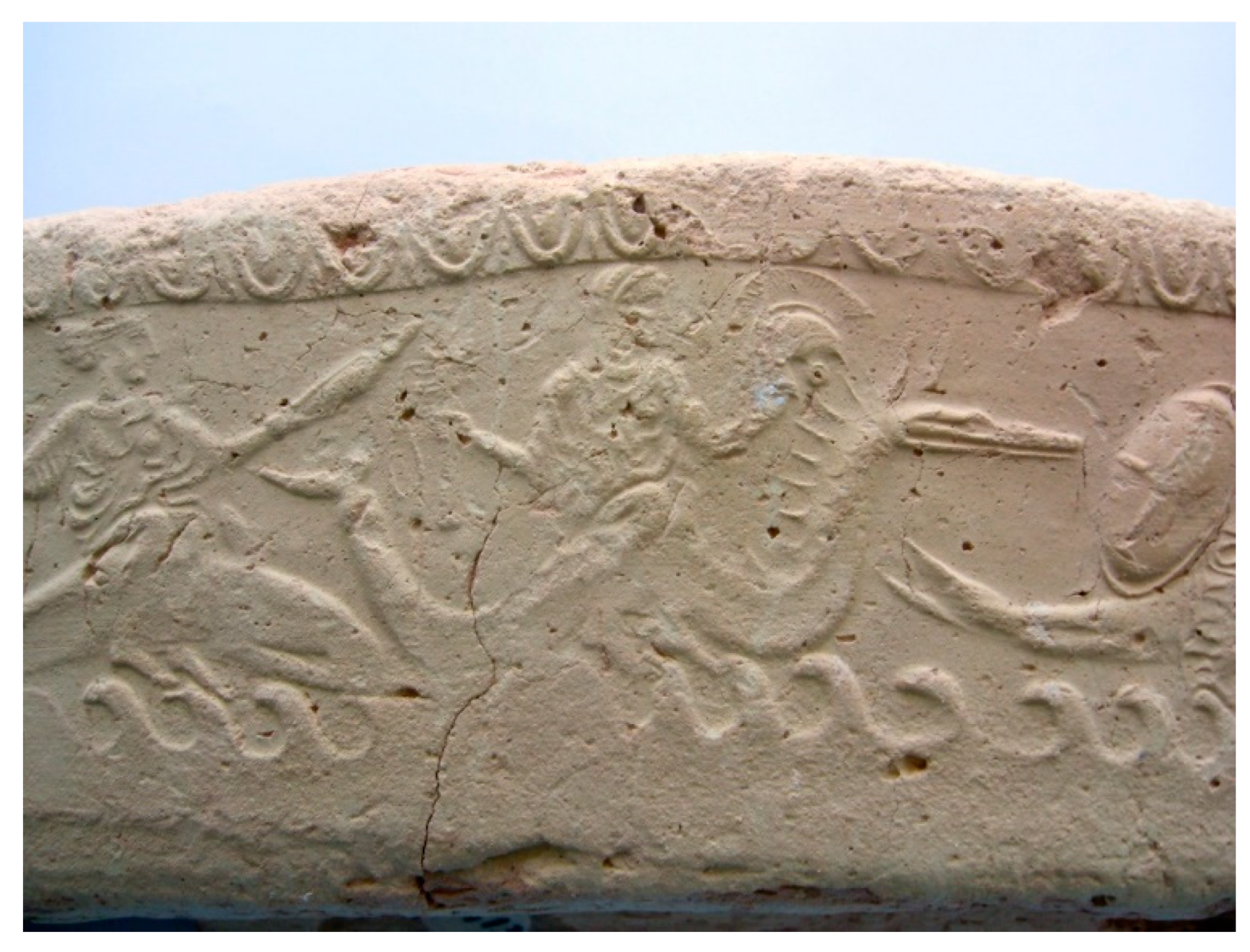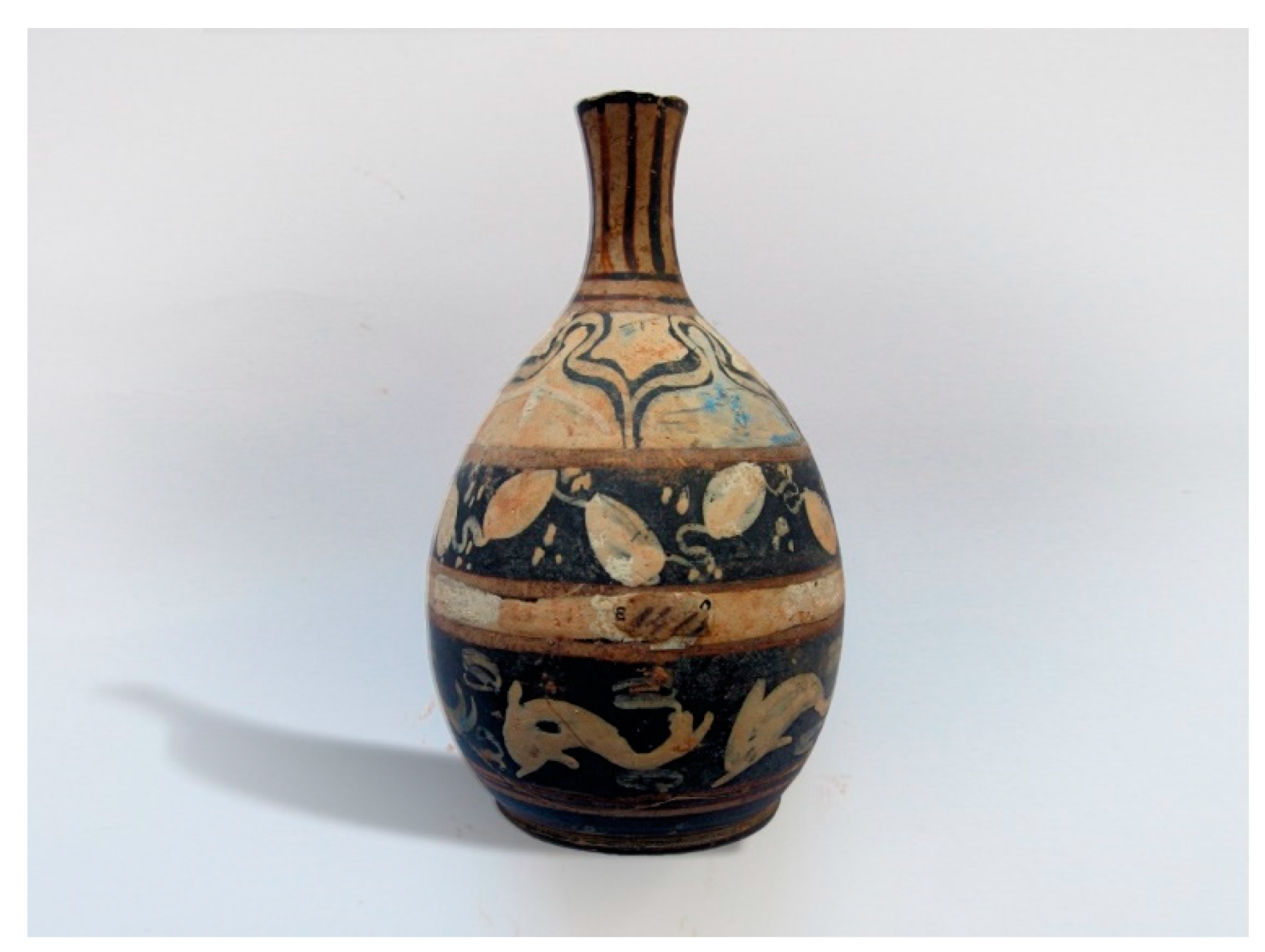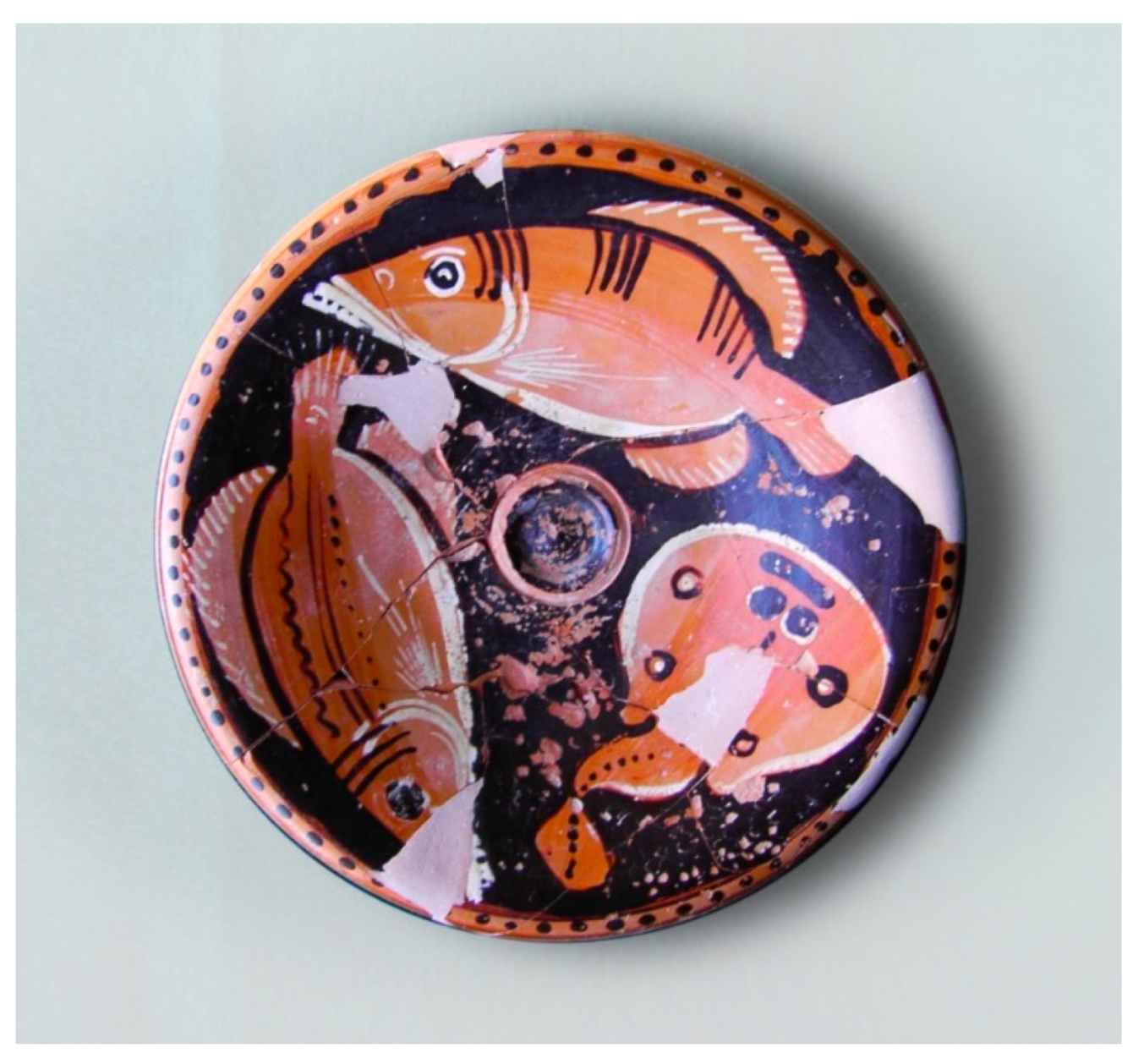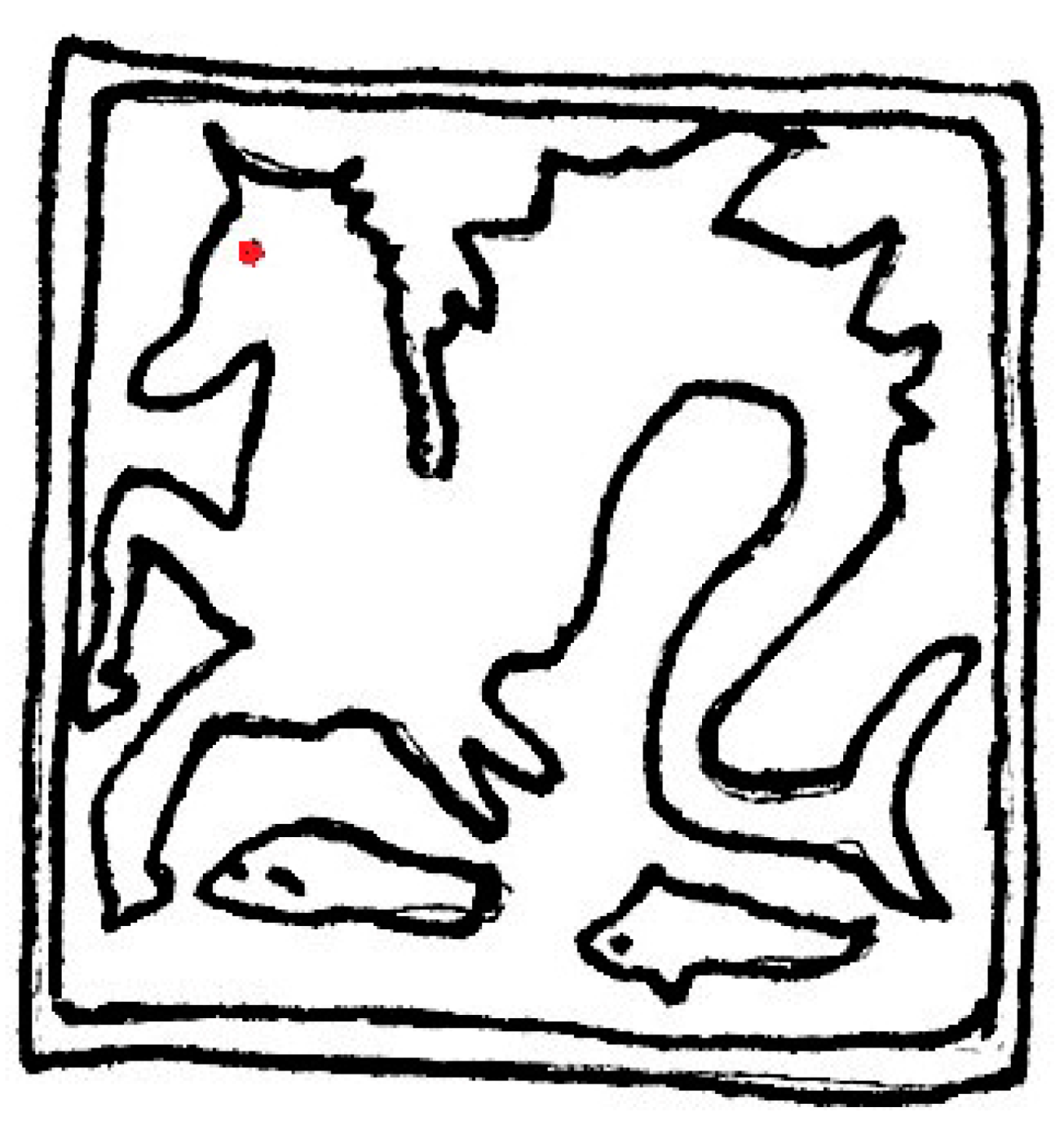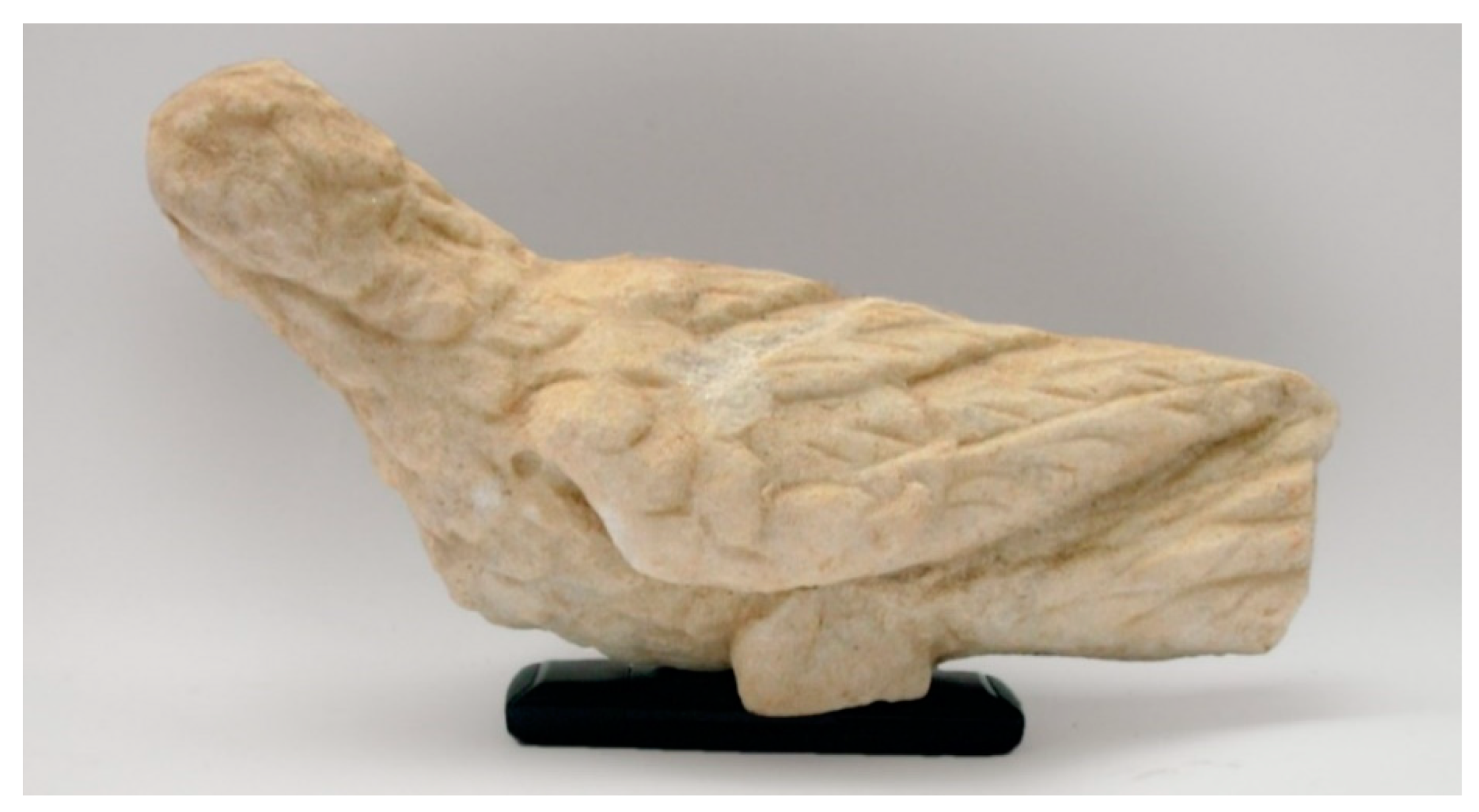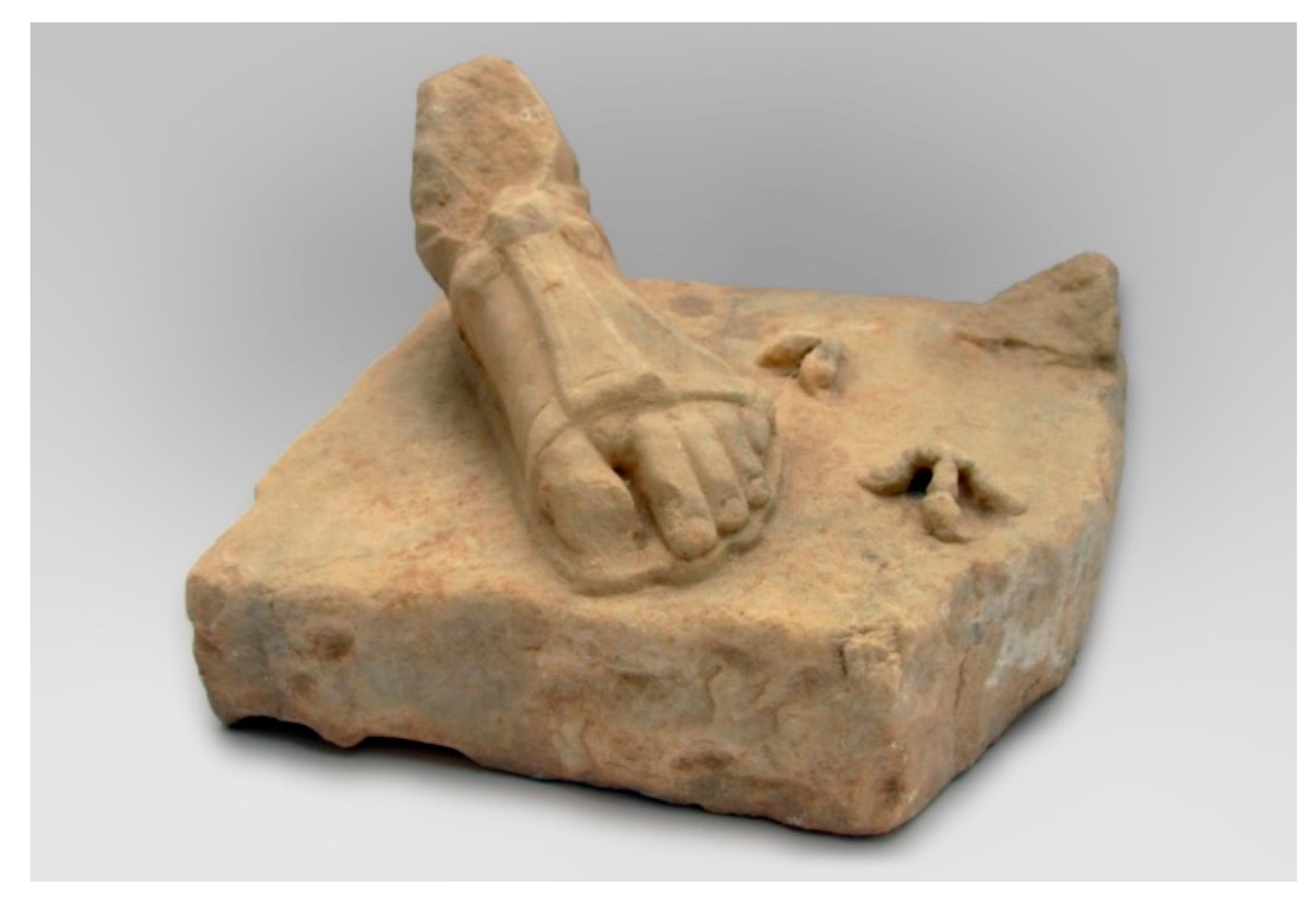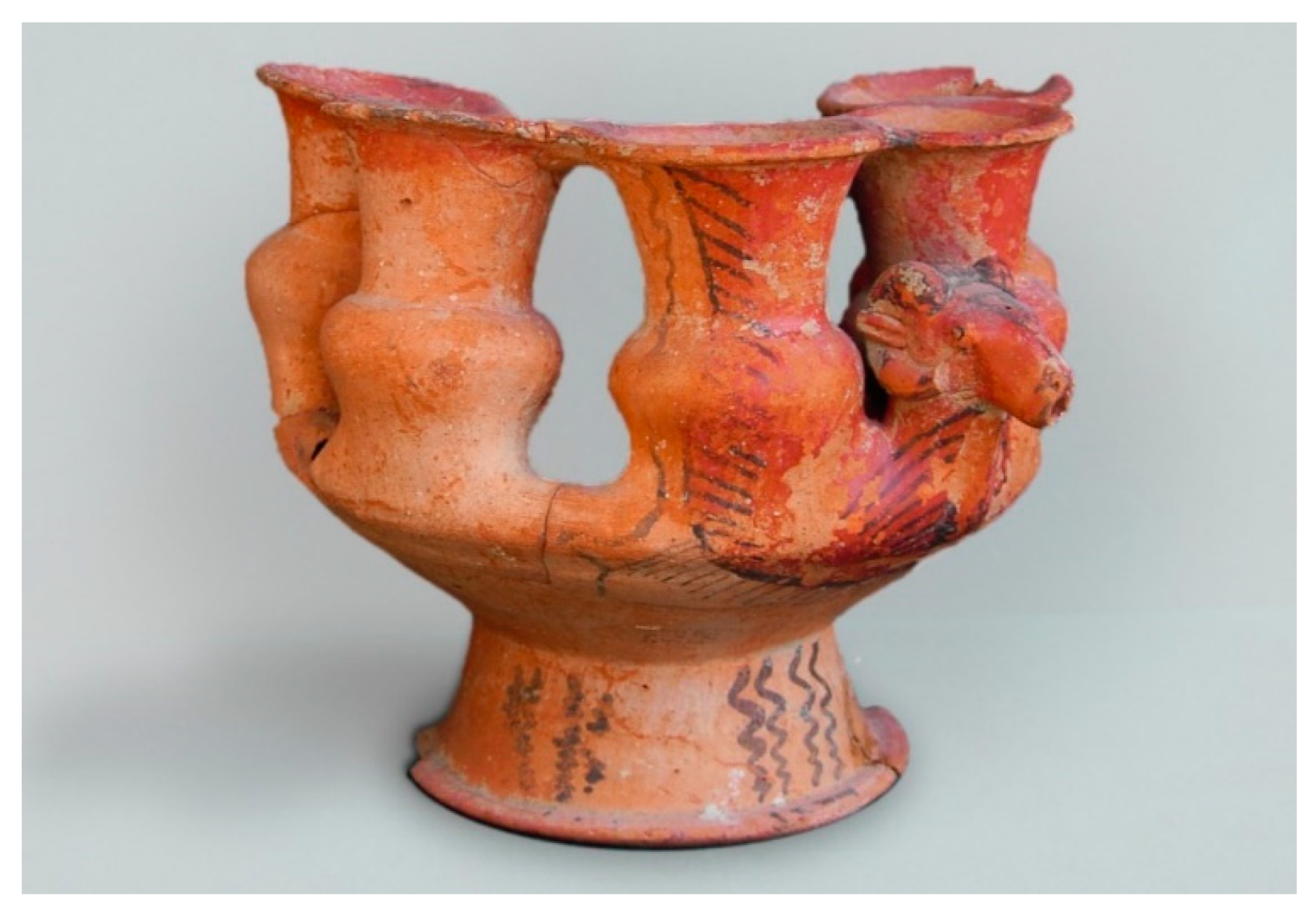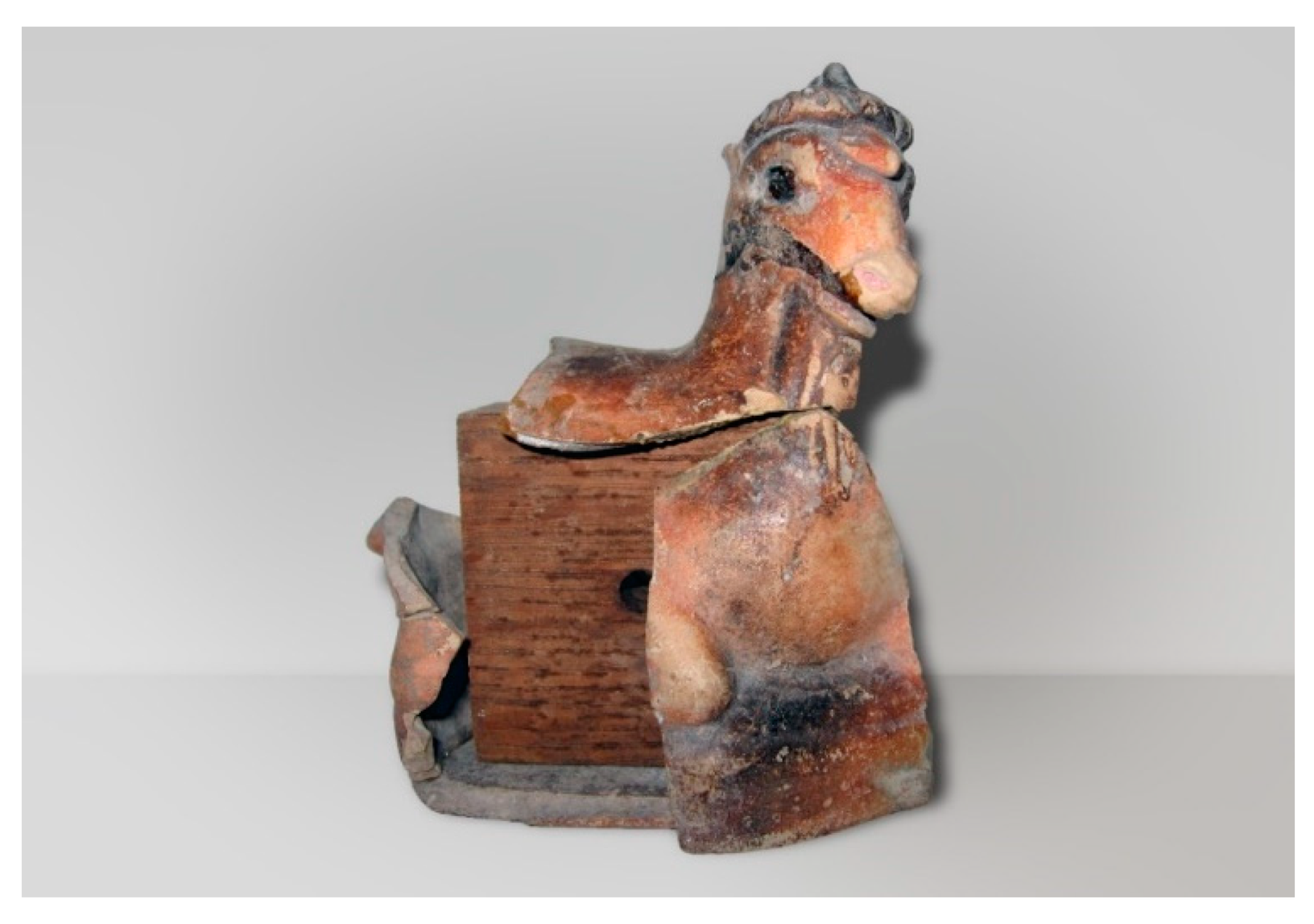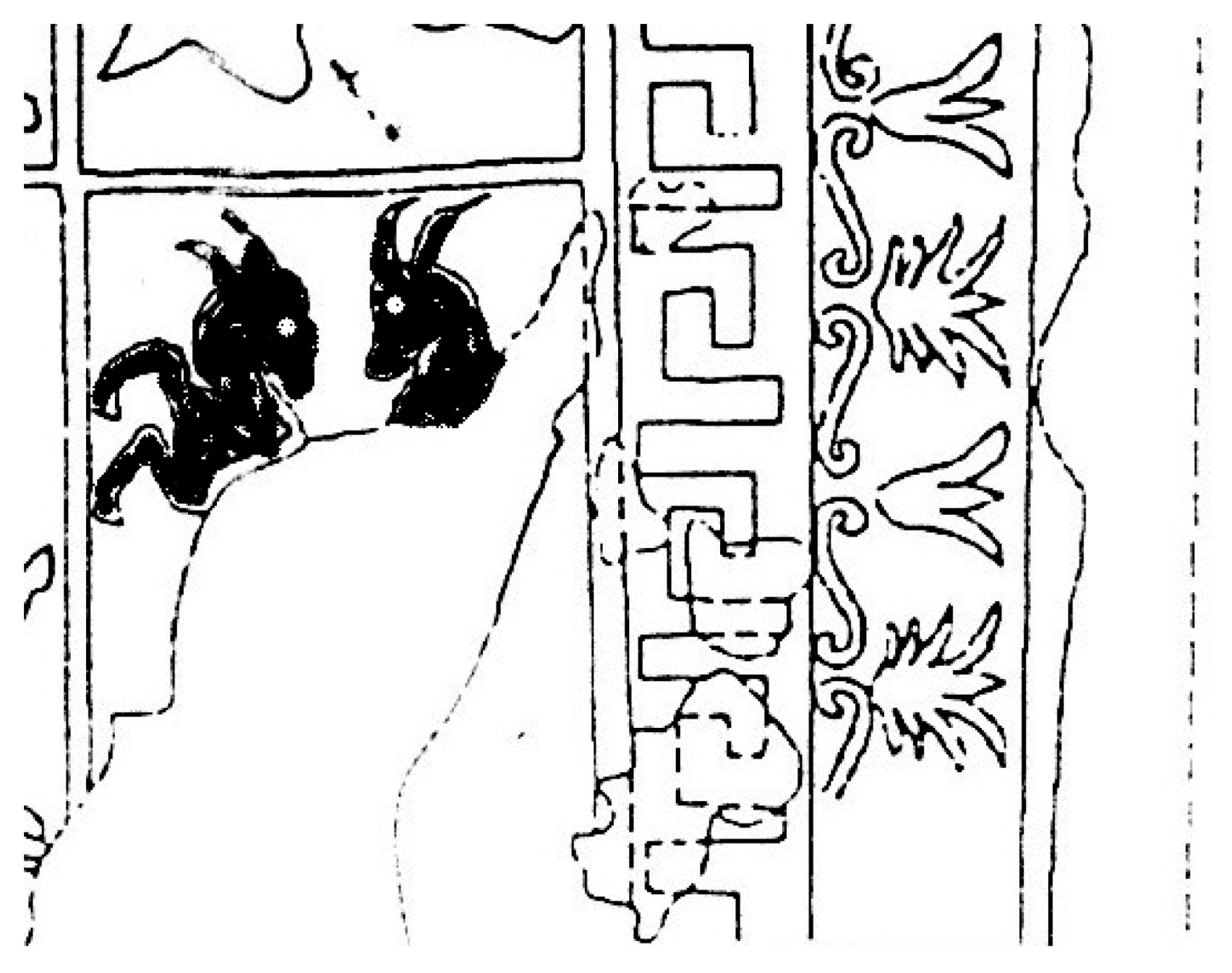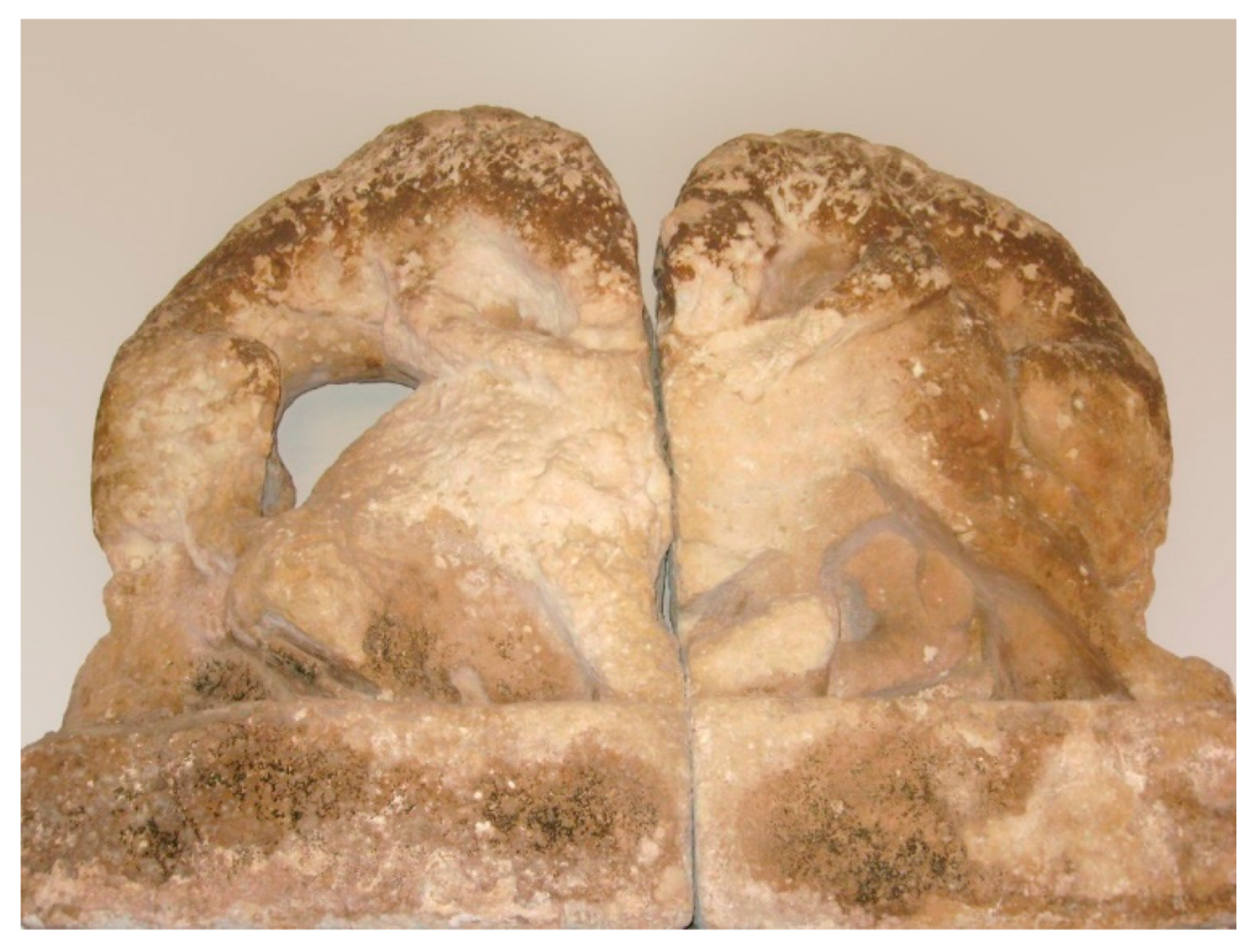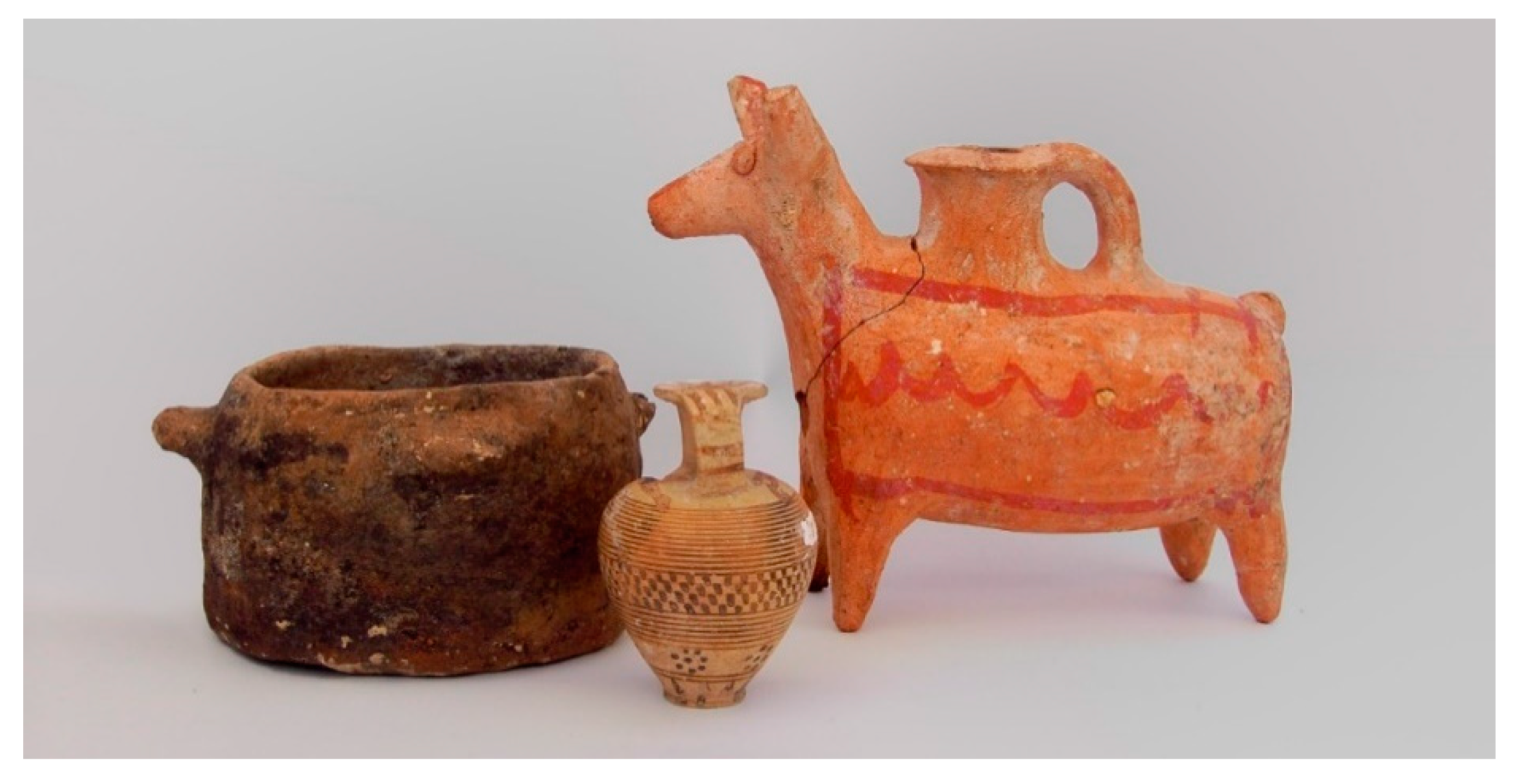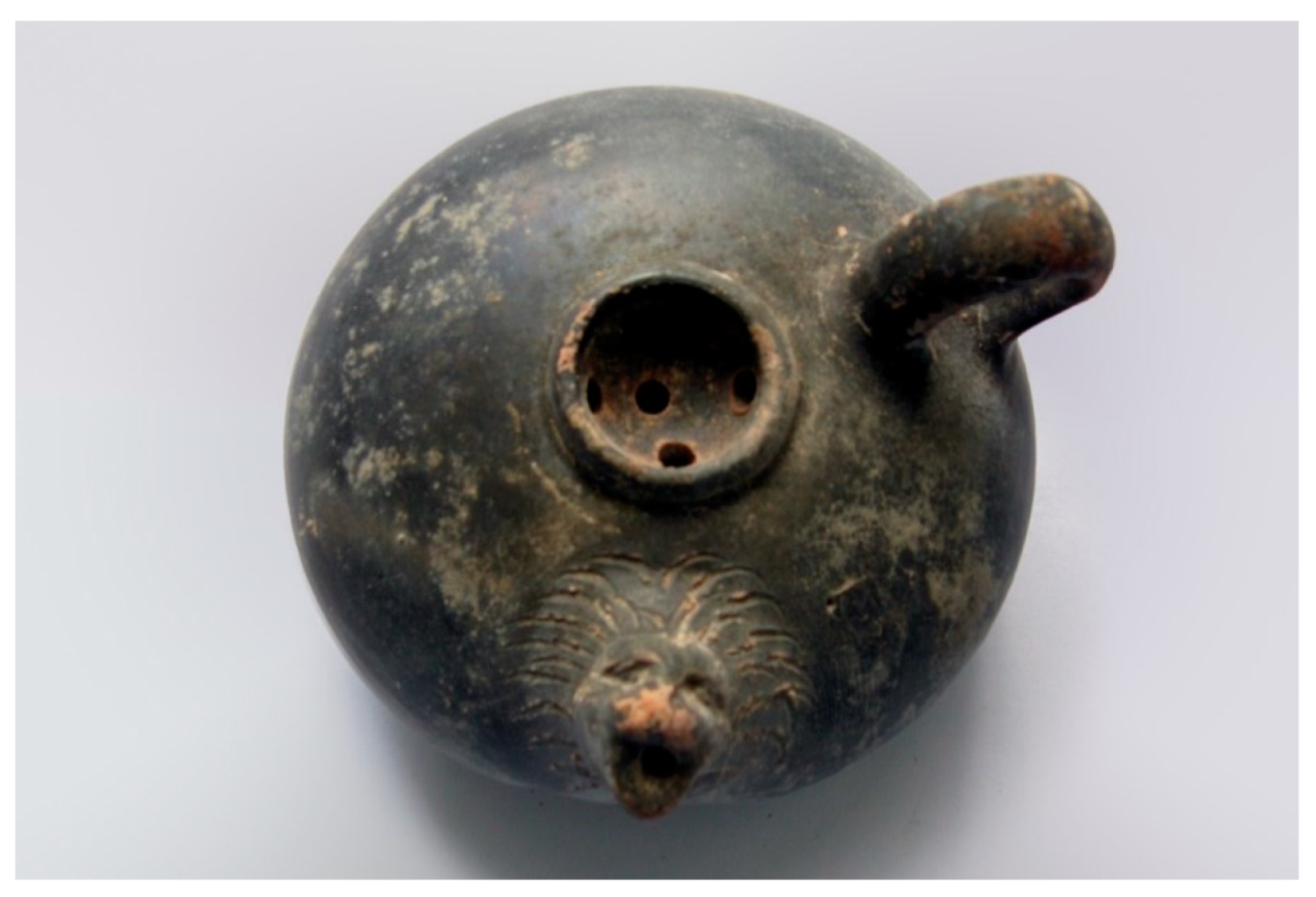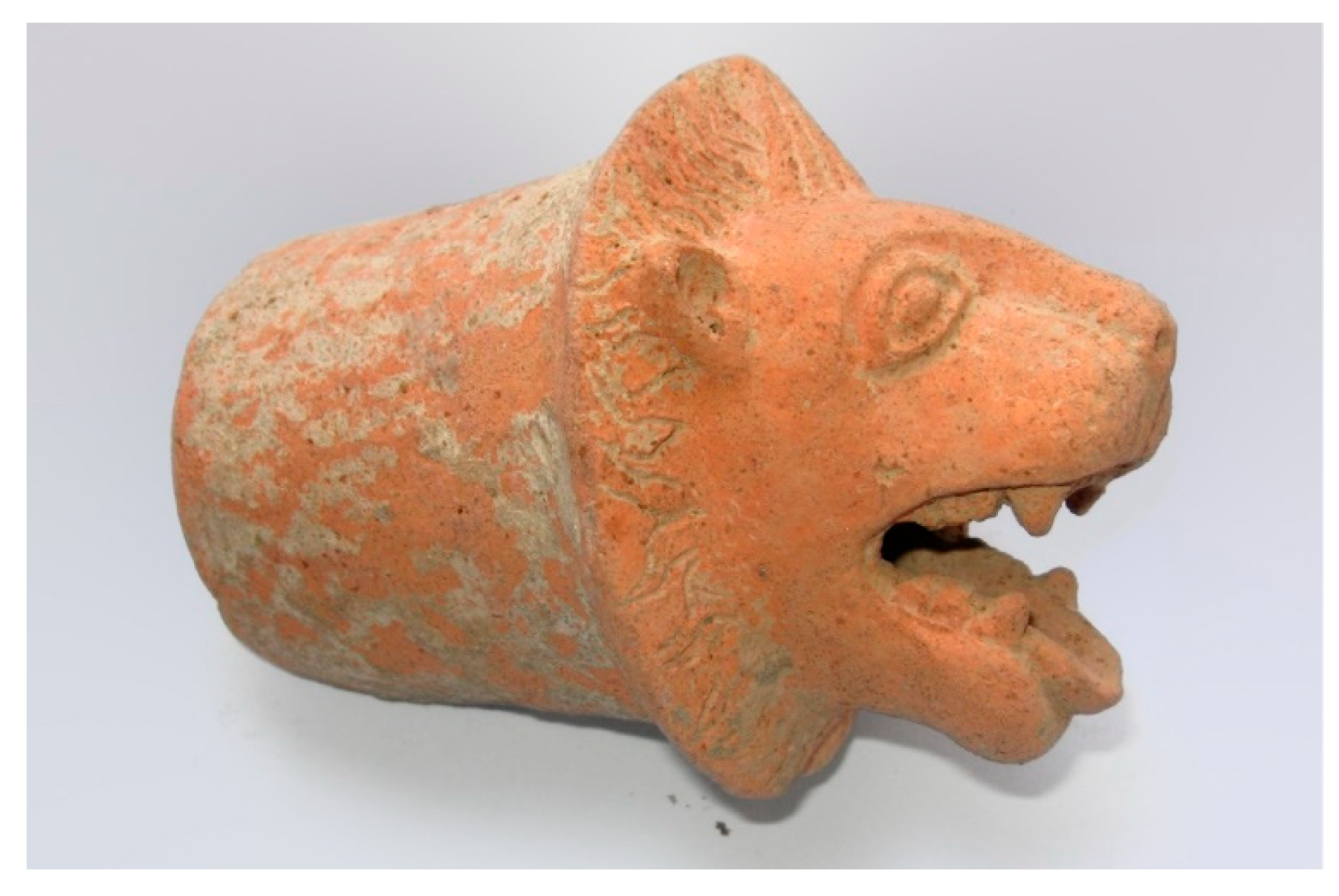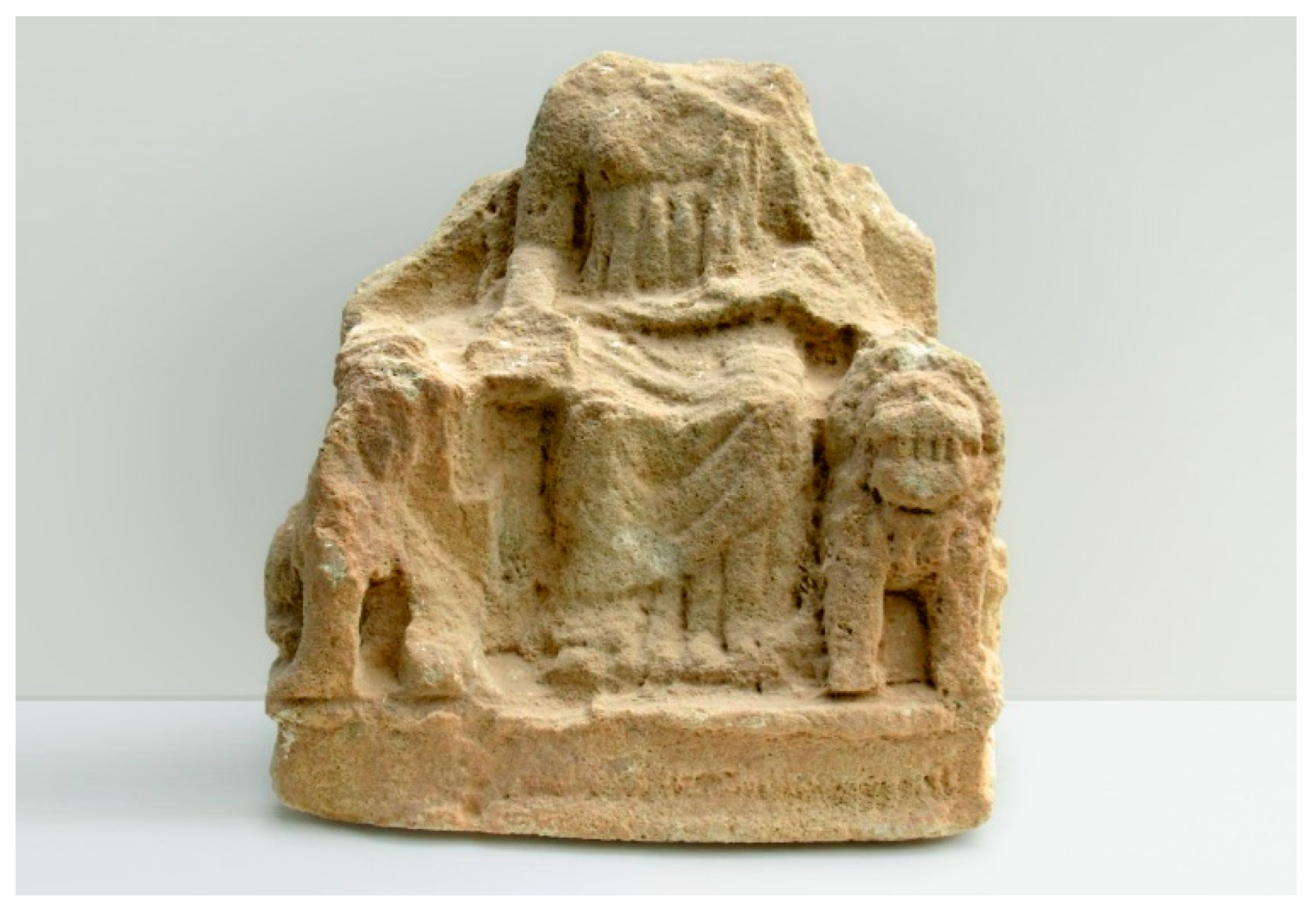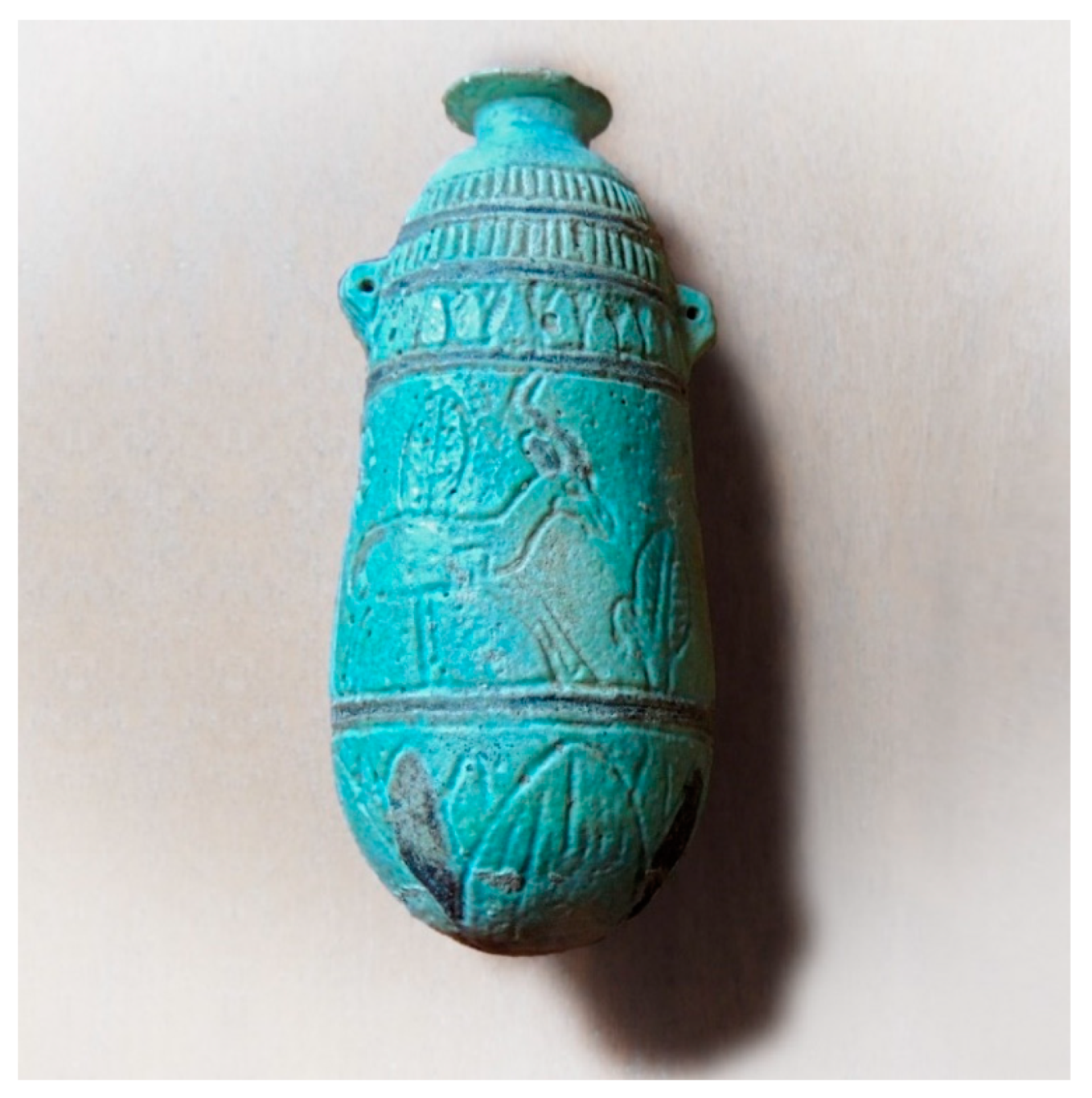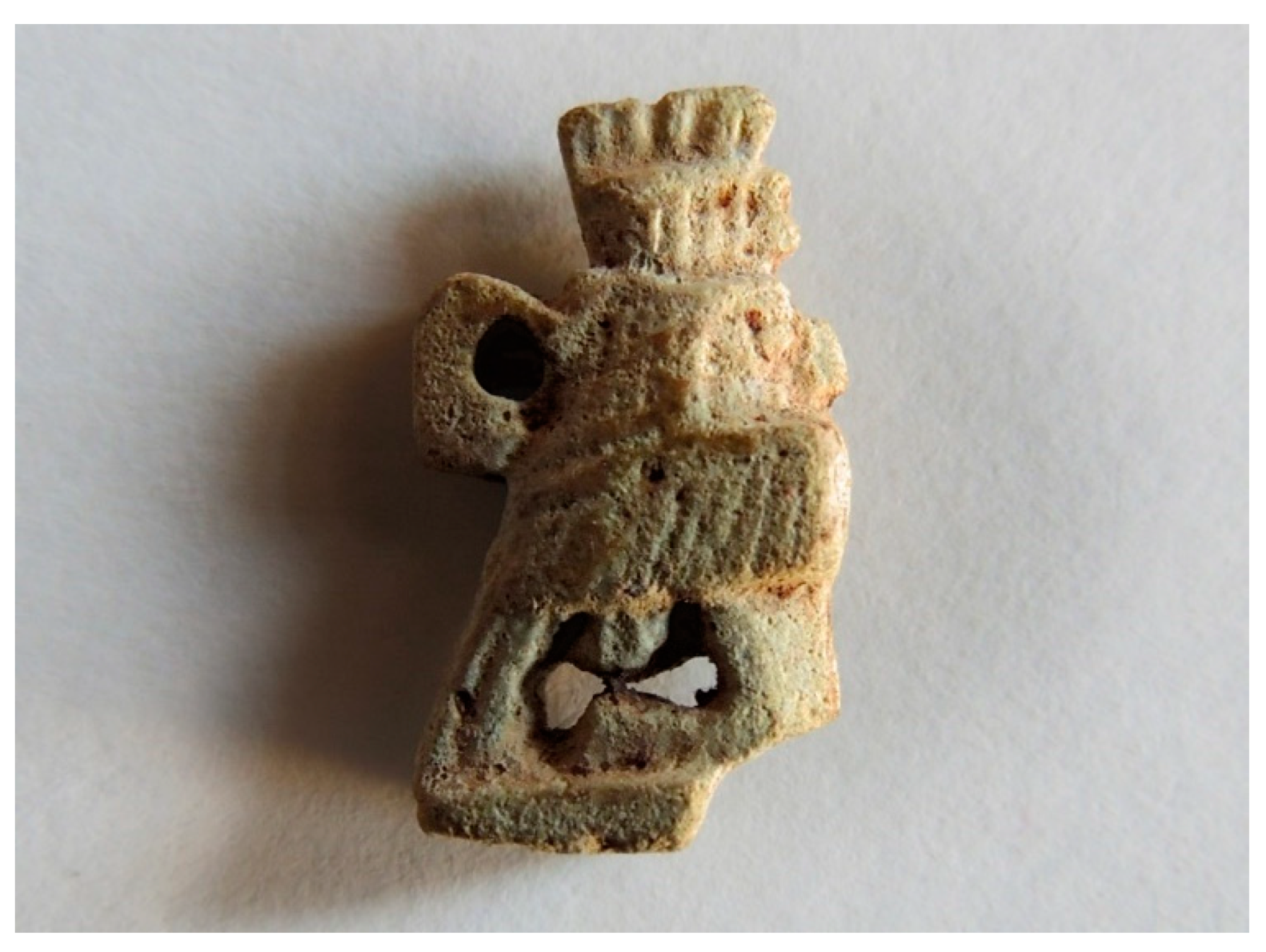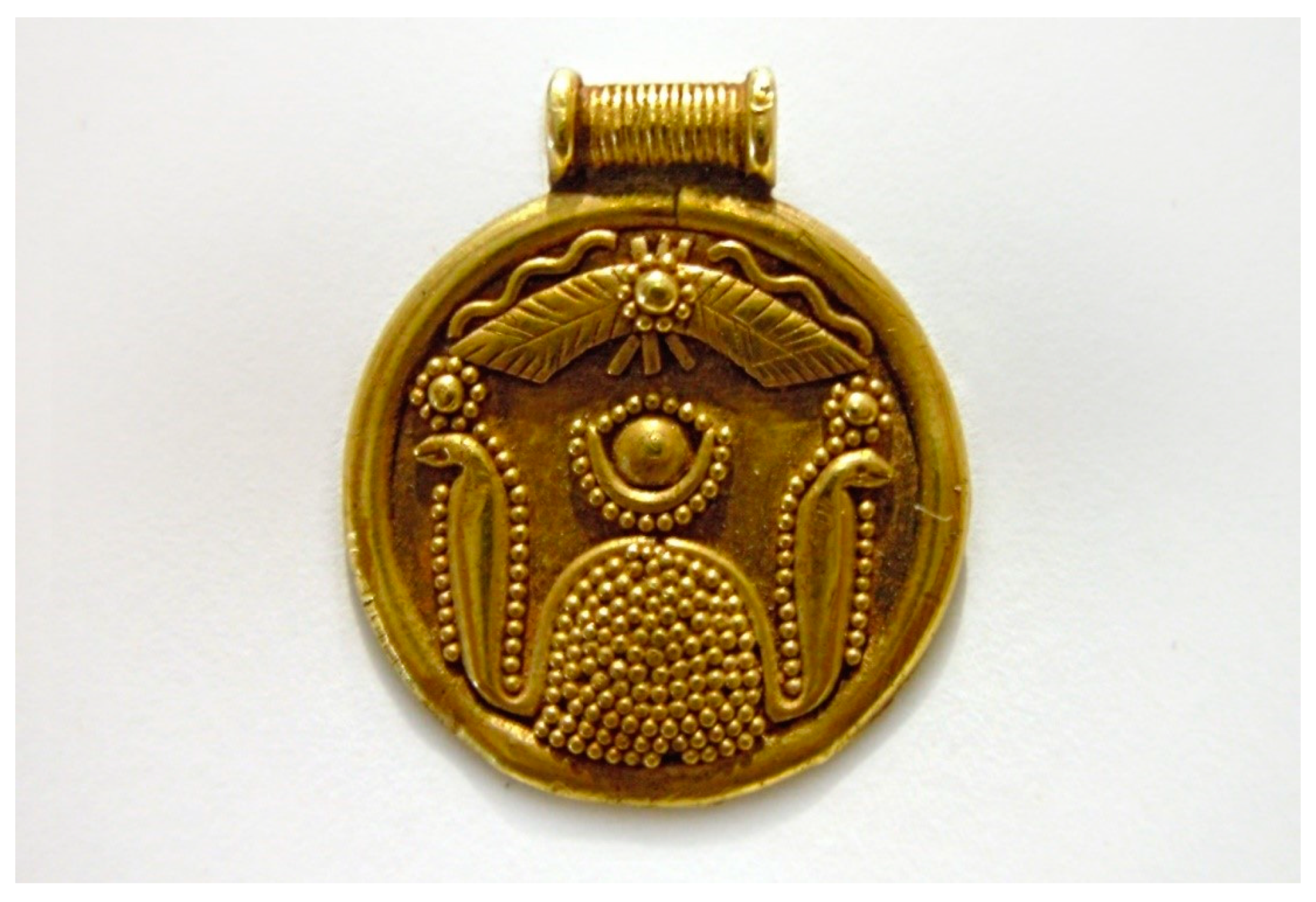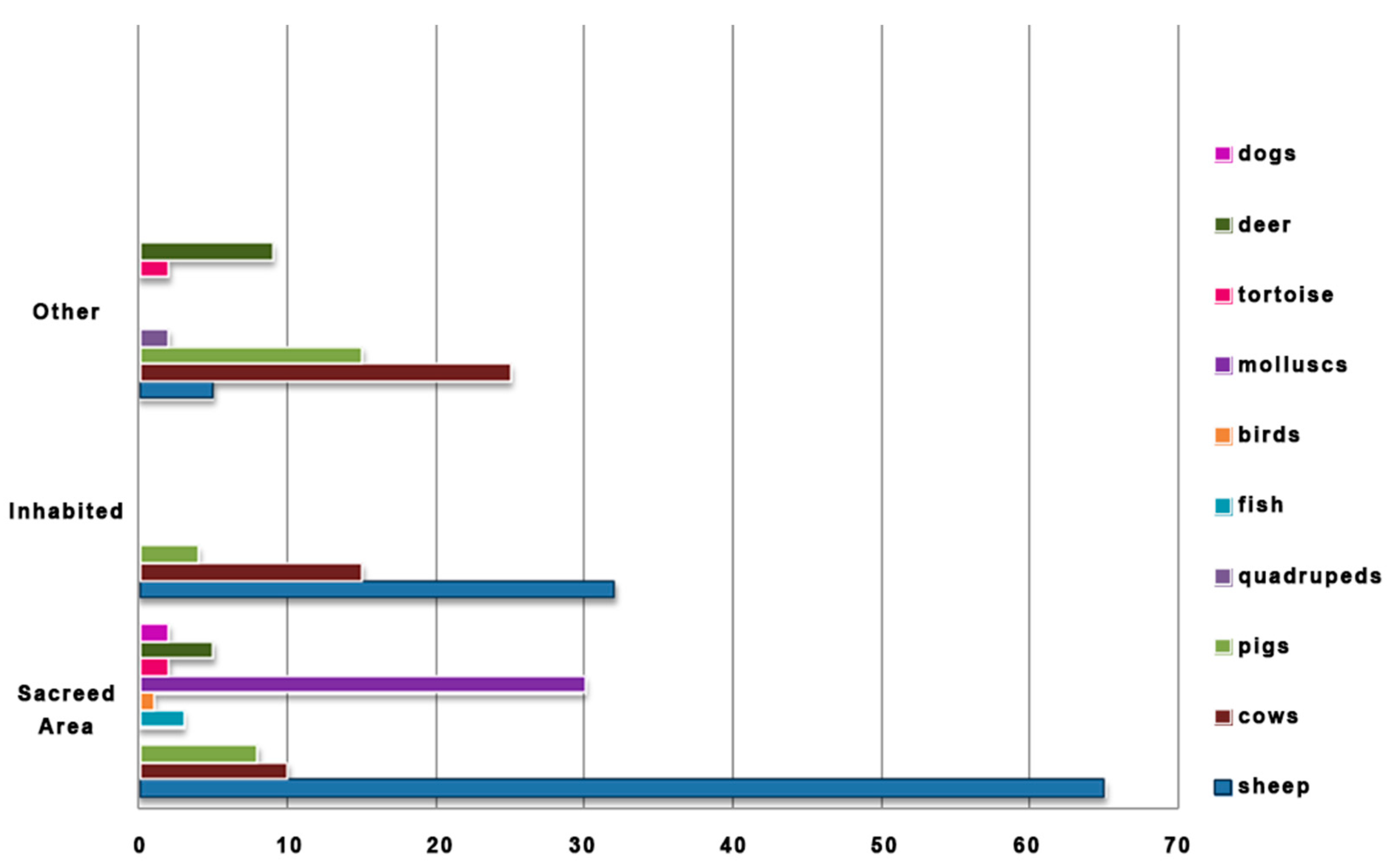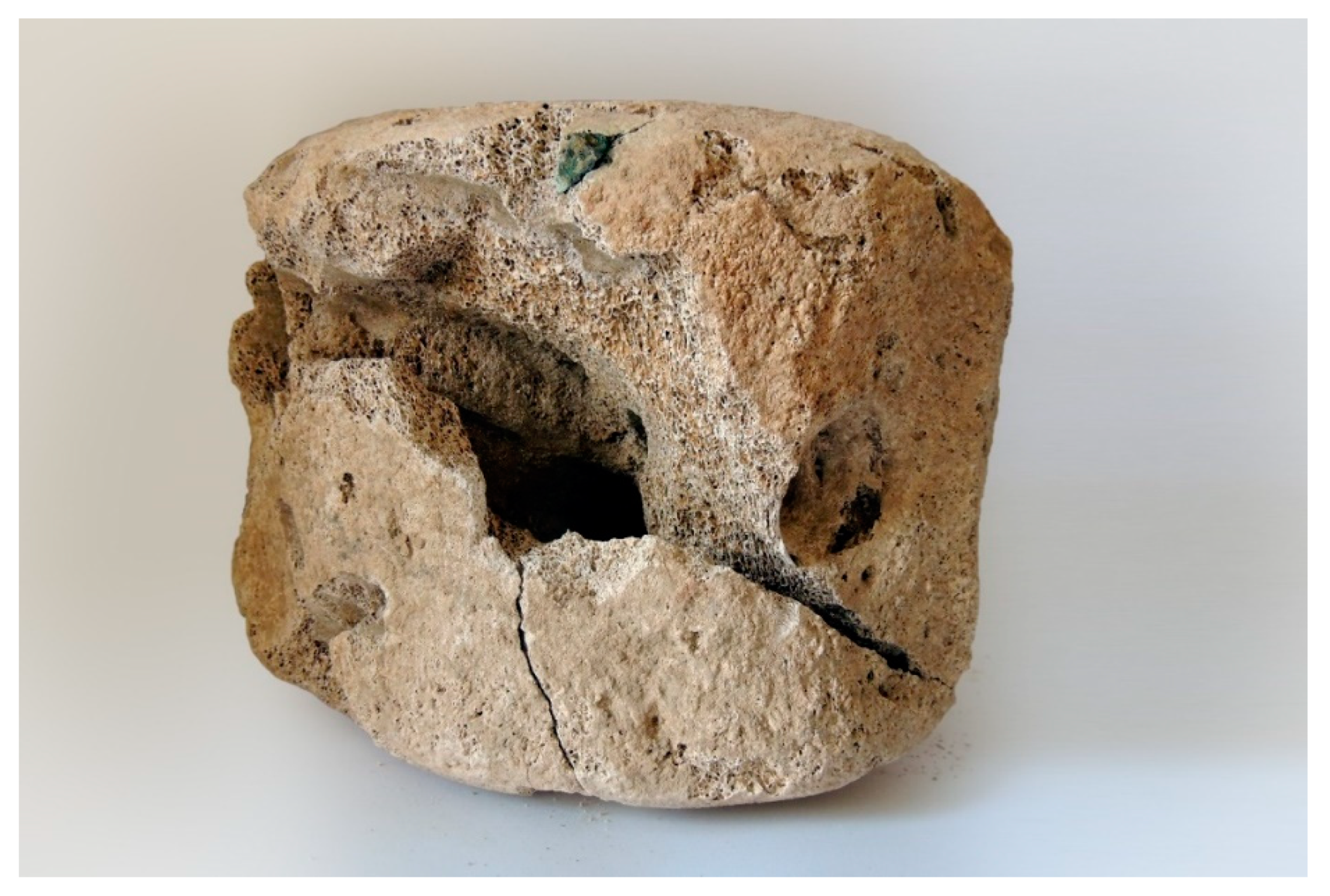This paper focusses on the animal presence in the archaeological records from a small island town in the lagoon of Stagnone Lagoon off the western coast of Sicily, in the province of Trapani, called Motya in antiquity (present-day Mozia). The aim of the paper is to present a preliminary overview of this material, which has not thus far been studied together. The objective is therefore to correlate the knowledge around the topic of the representations of animals in the material culture and remains of ancient Motya. After briefly introducing ancient Motya and the Whitaker Museum on the island, we will review animals by their kind: starting with fantastic beasts, moving from animals of the sea to animals of the air and the land, then creatures from Egyptian magical and religious tradition, and finally the faunal remains. Perhaps the most fascinating feature of ancient Motya, well reflected in the present paper, is its wide cultural interaction with the wider Mediterranean world—particularly the Greeks and Egyptians, in addition to the Phoenicians and the indigenous Sicilians.
The renewed interest in animal studies, of which the special issue on “Animals in Ancient Material Cultures” is an example, inspires us to focus on a single archaeological site—rather than a single animal as is the more usual approach. Our review can, however, not be comprehensive, that is, including every single animal attestation in the evidence on or around the island. For, even after over a century of excavations (including annual campaigns since the 1960s), only part of the island has thus far been excavated. Underwater excavations in the lagoon and the shoreline at Birgi Vecchi, not to mention the harbor at the southern bay of the Stagnone (present-day Punta Alga at Marsala), will doubtless provide additional material. Moreover, even a comprehensive catalogue of all animal depictions and physical remains would produce a publication the length of a monograph.
Phoenicians living across the Mediterranean, including Motya, left very few records of themselves. Little is therefore known about their history and religion beyond the archeological evidence, and the literary accounts by other ancient peoples, who wrote in Hebrew, Greek or Latin. There are consequently no surviving written sources that could explain how the inhabitants of ancient Motya felt towards animals or what they thought about the animal depictions on their artifacts. As the (zoo-) archaeological record remains incomplete, the written sources scarce, and the following presentation limited by its discrete division, any general conclusions—such as possible changes over time—would be meaningless. One more point of clarification might be in order, namely that beyond initial Italian excavation reports and/or the displays in the Whitaker Museum at Mozia, the material has not been presented to a wider audience before.
1. A Phoenician Town in Sicily
Describing the Phoenician settlements in Western Sicily, the ancient Athenian historian Thucydides pointed out three main towns: Motya, Palermo and Solunto.
3 The first of these towns, on which we will concentrate in the present article, Motya, derives its name from the Phoenician term meaning port or harbor (
mṭw’).
4 The town was founded by Carthaginian settlers in the 8th century
bce on what mediaeval monks came to call San Pantaleo, a small island with a roughly circular shape (
Figure 1).
5 While its name would suggest its initial purpose was to serve as a trading station, over the centuries the settlement grew to reach its maximum expansion (
ca. 45 ha. ≈ 111 acres), probably by the 5th century
bce, occupying the entire surface of the island. In 397
bce, the Greek troops of Syracuse besieged and destroyed the town. Excavations demonstrate that the Siege of Motya disturbed the archaeological records, in that objects were evidently moved for defensive purposes; and deliberate destruction would further have broken disassociated objects from their context.
Before his description of this “Siege of Motya” (397
bce), the ancient Sicilian historian Diodorus relates that due to the prosperity of the population the town by that time consisted of numerous, beautiful and artistically embellished houses.
6 That is to say that in the preceding centuries the Phoenician trading port had gradually grown into a flourishing and affluent town, which even coined its own money (featuring animals such as dolphins, crabs, eagles, horses and dogs). Motya was surrounded by a defensive city wall enclosing a small sacred pool—with its own shrines within a circular enclosure— industrious factories and productive workshops, sumptuous residential areas, as well as a Tophet temple and the so-called Sanctuary of the Cappiddazzu (Italian for “big hat”; devoted to an unknown local Phoenician deity). The town was connected to the shore of Sicily to the north by a narrow artificial causeway, which still exists today, over which carts with large wheels could travel.
7 Along the shores of the lagoon basins were constructed for mining salt by draining the water with the power of windmills. One of the most interesting houses for our present purpose, and to which we will return regularly, is the co-called House of the Mosaics located in the southeast of the town. Its richly decorated floor mosaics of black and white pebbles depict a wide range of real and fantastic animals.
As the Phoenician town was settled as a commercial center, Motya’s primary purpose was mercantile both in terms of trade and local manufacture. Motyan produce included terracotta figurines and ceramic vases (particularly Punic
amphorae), textile dyeing and weaving (especially purple, for which the Phoenicians were famous). The population’s mercantile interests ranged from exchanges with the native Elymians on western Sicily (from whom they must have obtained their agricultural produce and other foodstuffs), Punic settlements along the western Mediterranean, Greeks in the larger Greek world, the original Phoenician cities in the Levant as well as Egypt. These interactions explain the regular attestation of Phoenician as well as Greek and Egyptian artifacts on the island.
8 Indeed, the aforementioned House of the Mosaics also features a rich architectural display of Doric, Ionic and Corinthian elements. The island of Motya is probably best known today for the extraordinarily masterful life-size Greek marble sculpture dated to 5th century
bce, affectionally called the “Motya Youth” (as his identity remains a mystery).
9 An even larger, over life-sized limestone Egyptian statue dating from the 6th century
bce, of which only its torso survives, may have once stood in a two-columned Egyptian-style nave.
10 After the Siege of Motya, the town was resettled by the Carthaginians, though in reduced scale, while Lilybaeum (present-day Marsala) became the primary Punic settlement in western Sicily.
11 Motya thus lost its prominence and, while some activity continued into the Roman period, the island gradually ceased to be frequented.
In the early twentieth century, wine merchant Joseph Isaac Spadafora Whitaker (1850–1936) became the only owner of the entire island of San Pantaleo and launched the first archaeological excavations.
12 For about twenty years he devoted himself passionately to the rediscovery of the ancient town, identifying some buildings of Phoenician-Punic Motya, which are still under investigation at present. To display the archaeological finds, Whitaker built a special room on the island, next to his home, thus creating one of the first museums linked to its territory. Displaying objects in the location where they were found is a current policy now but was extremely unusual for those times. In the museum, whose present arrangement dates to 2001, not only the finds of the Whitaker collection are on display, but also a selection of those objects coming from the excavations carried out by the many Italian and foreign archaeological campaigns since the postwar period.
13 The island itself is now owned by the Whitaker Foundation.
2. Marvelous Monsters of Motya
Our review of the artifacts depicting the animals of Motya begins with the fantasy world.
14 The island lies at the center of the Western Mediterranean, at a crossroads of peoples and trades routes. Connecting Sicel-Italic, Greek, Egyptian and Punic-Phoenician traditions, it may be safely assumed that various beliefs, mythological tales and divine representations, belonging to people who were attending the settlement on the island, are represented and revered—even if in the process they changed part of their original meaning. How the people of Motya understood these fantastic beasts cannot be known, as Phoenicians left few literary sources about themselves—and no written accounts from Motya itself survive.
Most of our information about the myths and religion of the Syro-Palestine peoples come from the texts of Ugarit.
15 These Levantine myths describe the characters and deeds of a relatively small number of divine and monstrous figures, strongly and mutually linked by a series of positive relationships (love, alliance, kinship) or negative ones (antagonism, resentment, alienation). Many deities have epithets that connect them to animals and often the numinous and animal spheres are not clearly differentiated. The divine and monstrous figures are, nevertheless, described in human terms: they behave like humans, eat, drink, experience feelings of joy or anger, and so on.
The most commonly depicted monster in Motya is the sphinx, a being found across different ancient cultures (
Figure 2).
16 In Egyptian representations, the sphinx is portrayed with a male human head and a leonine body, usually reclining with its front paws in offering position. It is considered the embodiment of royal authority and the guardian of thresholds.
17 The sphinx is closely related to death and dying and the passage into the afterlife. It is a protective being, not a frightful figure. By the early 1st millenium
bce, Levantine Phoenician craftsmen fashioned ivory inlays depicting winged striding sphinxes in profile—not seated or reclining.
18Motyan sphinxes, however, are commonly depicted according to Greek iconography. In Greek mythology, the sphinx is initially portrayed as a man or woman, indiscriminately, with or without wings.
19 From the 6th century
bce onwards, however, the Greek sphinx became codified as a winged figure with the body of lion and the head of a woman, occasionally with a female torso, sitting upright on its hind legs. Although the sphinx is already mentioned in the Homeric epics, it is only Hesiod who first narrates its myth.
20 She is the daughter of Typhon (Chaos) and Echidna, and the sister of the Nemean lion. Even if not physically described by the poet, she is called “the ruin of Cadmeans”, i.e., the inhabitants of Thebes. She was sent by Hera to plague the region and kill all those who could not solve her riddle. The answer was ultimately uncovered by Oedipus and the sphinx promptly jumped off a cliff. The Greek sphinx is therefore a monstrous being, both cruel and enigmatic, a symbol perhaps of perverse and dangerous femininity.
The oldest depiction of a sphinx found in Motya is on an
alabastron (a small container for ointments, unguents, or cosmetic powders), of Corinthian production, dating to the late 7th century
bce.
21 A very humanized creature, wearing earrings and a fashionable headdress, the
sakkos (a kind of cap to gather her hair) is depicted on the lid of a red-figure
guttus (a small spouted libation vessel) dated to the late 5th century
bce (
Figure 3). Sphinxes are depicted on small domestic altars, the
arulae, found in limestone or pottery, dating between the 5th and 4th century
bce, as well as on architectural reliefs, pointing to a religious, apotropaic function (
Figure 2, above).
22The sphinx depicted in profile, closer in appearance to the Phoenician iconography, is found on objects specifically related to religion, such as cake molds, to make the sacred bread offered to the gods.
23 A similar practice is attested in the Bible, for, while condemning foreign cults, the prophet Jeremiah mentions that the women of Jerusalem knead cakes for the Queen of Heaven (to be identified with Astarte), the engraved image of the goddess.
24 Still in the 5th century
ce, a particular practice of divination was known, consisting of throwing cakes in the water that would float or not according to the will of the goddess.
25 While depictions of sphinxes on vases may have been dictated by purely decorative reasons, the representation of the monster on objects of worship, such as molds and
arulae, involves religious motives that are yet unknown.
Another mythological being attested in Motya is the centaur—half man, half horse—almost always portrayed as short-tempered, violent, wild, rough and brutal, unable to tolerate wine. The centaur’s main mythic characteristic is to embody all the qualities and all the flaws of the human race, however raised to the extreme. He played diametrically opposing roles, of great wisdom—such as Chiron, tutor of Achilles—or of incredible brutality—such as the participants in the wedding feast of the Lapiths. Indeed, centaurs belong to a special mythological category, because they are not so much hybrids (combinations of composite parts) as “doubles (δίφροί)” of man and horse at one and the same time. As doubles, they share with men some qualities, such as courage and strength and, at least in part, some aristocratic forms of chivalry and sociality. However, the equine fury, the usual drunkenness and violence directed mainly to their wives, banish them from socially acceptable behaviors and reconnect them instead to primitive forms of sexuality and to the world they lived in the wild and mountainous slopes of Mt. Pelion in Thessaly. The figure of the centaur, like the sphinx, is thus formed of a human element dominating an animal part and symbolizes, from the psychological point of view, the merging in one individual of two opposing trends: the strength of the spirit of wisdom, and the rush of instincts as underlined in the Mediaeval Liber Monstrorum (ca. 700 ce): “Centaurs have a shaggy head, to some extent very similar to a human one, with which they can start talking: but their lips, unfit for human speech, cannot organize any sound in words” (1.7).
Some representations of centaurs can be found in Cassite-era depictions where an image of a winged archer with the body of the horse recalls the indissoluble link created between the warrior and his horse.
26 The first Greek images of centaurs are found in the region of Euboea, dating to the Protogeometric (10th century
bce),
27 while a monumental Greek amphora of the end of the 7th century
bce. takes its name from the episode of Hercules’ killing of the centaur Nessus.
28 The figure was widespread in the ancient Western Mediterranean. The half man, half horse creatures are depicted on small Sardinian bronzes from the Nuragic period as well as later in monumental Etruscan sculpture.
29A reclining centaur who has recently been identified as Pholus is depicted on two
arulae displayed in the museum of Motya (
Figure 4).
30 This centaur, gentle and wise, appears in the fourth Labor of Heracles, the Erymanthian Boar-Hunt. To honor the hero, when visiting the centaurs’ community, Pholus offers roast meats and wine. The position assumed by the character on the
arulae suggests the banquet. The question of why a centaur is depicted on an object of worship in a Phoenician town must at present remain unanswered. Conversely, the presence of a centaur on an engraved carnelian scarab-seal, fashioned in the
a-globolo technique—a style generally designated as Etruscan-Italic—is plausibly explained as the adoption of this figure as a sign of personal recognition by an inhabitant of Motya.
31 But there also are, as mentioned, centaurs that have preserved their wild character, as in a Centauromachy depicted on the rim of a
louterion (lustral basin), dating to the 5th century
bce.
32 The choice of the scene here must have a purely decorative meaning, since it is a repetitive pattern, well-suited to the circular shape of the support.
On some
arulae dating to the 5th–4th century
bce, scenes illustrate fighting creatures, usually horses, attacked by a pair of griffins, creatures with the body of a lion, and the head and wings of an eagle, considered symbols of divine power and guardians of gods (
Figure 5).
33 A similar fighting scene, with a single griffin attacking a horse—derived from coroplastic models—is found in a panel of the mosaic pavement of the House of the Mosaics, where the decorations, made with black and white river pebbles, represent animals alone or fighting with each other.
34 The iconography is well-represented in Punic hard-stone glyptics. It seems now generally accepted that the seals are
emblemata of Carthaginian families involved in the management of civic and colonial power between the 6th–4th century
bce. We can thus safely assume that the imagery was chosen as part of the mosaic composition because it is a public building of Punic tradition.
35 An isolated griffin depicted on a scarab was also almost certainly an item used as a personal seal.
36Indeed, the image of the griffin persisted continuously for some six thousand years in the Mediterranean and Middle East.
37 This iconographic continuation, it may be suggested, was due to its formal aspect, which rendered the griffin a suitable and unambiguous symbol of aristocratic authority, namely the combination of elegance and force, embodied by the two most representative animals of power and nobility on land and in the air respectively—
viz., the lion and the eagle. The image of the griffin even lent itself very well to serving as an allegory for the dual nature of Christ, divine and human; and this explains the popularity of this theme also in Christian symbolism.
38In ancient Mesopotamia, the griffin was a frequent religious and decorative motif.
39 Besides the eagle-headed type that became widespread, there also existed a lion-headed type, with the paws and wings of an eagle. The griffin could be employed as a decorative pattern, without a necessary religious or naturalistic reference.
40 From Mesopotamia the motif spread to Syria and Palestine, Anatolia and then Greece. The fantastic beast features notably among the wall paintings of the Palace of Knossos, Crete, appearing among the struggle of man with the animal world. The splendid marble
trapezophoros (ornamental table support) of Aphrodisia, dated to the late 4th century
bce, from a tomb in Ascoli Satriano (Apulia), depicts two griffins devouring a deer in highly artistic detail, which illustrates a similar motif—in the round—as the
arulae from Motya.
Two demon heads with horns and a lion’s snout are probably associated, however distantly, with Near-Eastern iconography. Nonetheless, the scene in which they are depicted—a partially preserved coroplastic mold—is evidently connected with Greek myth and iconography, as it portrays the second Labor of Heracles, the killing of the Lernaean Hydra (
Figure 6).
41 The latter monster, whose lair was the swamp of Lerna in Argolis, has the form of a large snake equipped with a single viper’s tail and multiple heads, of which only one was immortal. The monster was so poisonous that its breath and even its smell could kill. The heads could also regenerate when cut, so the only way to make it harmless was to cauterize the neck immediately after beheading it.
42 The oldest images of the Hydra date from the end of Orientalizing period and are probably related to remote oriental figures in which a human fights and kills snake-tailed monsters.
43 The monster only appears in scenes referring to its death at the hands of Heracles. In connection with the Hydra and Pholus (mentioned earlier), it is interesting to note that the episodes of the Labors of Heracles occur frequently among the artifacts of Motya—evidence of the hero’s great local popularity; a hero who shared many similar aspects with the Phoenician Melqart.
3. Creatures of the Deep
Monsters of these remote ages did not only dwell among men on land, they also inhabited the abyss. The surviving Ugarit texts further document many monstrous figures. From these, we learn that Baal fought against the “70 sons of Athirat”, the primordial mother goddess with strong ties to the marine world, who is wife and companion of El, from whom are born divine generations along with chaotic and monstrous creatures that populate the universe and that must be annihilated or confined within limits so as to become harmless to the cosmos.
44 In the myth of the struggle between Baal and Yam (the sea), the central motif is the struggle between the two entities against chaos. Similar figures can be found in Biblical passages, in which marine monsters represent chaos and require being tamed so as not to endanger the order of the natural world.
In Greek myth, Okeanos, the divine dark sea, the progenitor of the gods as well as the sea of death, the “river” encircling earth’s continents, was also the abode of fantastic beasts with the bleak appearance of monsters, evil spirits that may have originally represented both an effective metaphor for the dangers of navigation, or a possible protection for those terrible voyages. While in the Archaic period the various monsters act separately, from the Hellenistic age onwards these figures form the so-called sea
thiasos, or the entourage of sea gods, reminiscent of the procession of Bacchus’s
thiasos. Among the female figures are the Nereids, always depicted as graceful young girls, sometimes with green hair, although according to Pliny the Elder they were not immortal, they usually died on the beach like cetaceans and possessed a monstrous body with fish scales.
45The retinue of Okeanos does make occasional appearances in the Motyan evidence. In any case, in their human form, they for their part used as mounts several marine animals, both fantastic and real. Among the first at Motya, we find the
pistrix or
cetus (from the Greek κῆτος), a marine monster in the shape of a sea serpent with the head of a dog and the tail fin of a fish. The
pistrix was occasionally called “sea dog”, but the literary descriptions insist especially on the crested head, the power of the flaming gaze and the terrible saw-like teeth.
46 In myth, the
pistrix appears in two similar episodes: a girl (Hesione or Andromeda) is tied by her father to a rock and offered as a sacrifice to a sea monster.
47 From ancient Greek nautical maps to the Renaissance, the
pistrix was used as a symbol of the fear of the unknown.
48At Motya
pistrices are found in a less violent scene on the rim of a
louterion, as mounts for the Nereids, who carry weapons to a hero (
Figure 7). This scene must be understood as a reference to the story of the armor of Achilles, for indeed it was the Nereid who delivered the weapons sent by his mother Thetis.
49 The most famous depiction of a
pistrix is the one preserved in the Archaeological Museum of Naples, in a group of sculptures, dating to the 1st century
bce, from Vedio Pollio’s Villa in Posillipo, in which the
pistrix is similarly used as a mount by a Nereid.
On the rim of the same
louterion we also find dolphins together with the
pistrices and Nereids. On the rim of another Roman marble
louterion these marine mammals are shown in pairs while jumping out of the waves
50; and on a bottle made in the workshops on the island of Lipari in the first half of the 3rd century
bce (
Figure 8)—probably a cosmetics container, as a yellow powder inside proved to be goethite, a mineral used in ancient times for eyeshadow.
51 In ancient myth, the dolphin was always considered a friendly animal, often the savior of sailors and castaways, as in the myth of Arion or the foundation of Delphi, named in honor of a dolphin.
52 It was also believed that the souls of drowned sailors would return to live in the form of a dolphin, regaining possession of that vital force that the sea had taken from them.
53 Their connection with Dionysus is well-known (
Hom. Hymn 7)—starting with the tale of the Tyrrhenian pirates; the association with wine consumption and the sea world is illustrated by the mammals (many of them as musicians) painted on cups, kraters,
dinoi and other sympotic vases, as well as by the representations of maenads holding fish, from the Archaic period onwards. A terracotta dolphin was among the votives of the 15th century
BCE sanctuary at Aya Irini on Keos, offered to a god generally recognized as Dionysus.
54A particular type of plate, known as the “fish plate”, is characterized by the depiction of almost all known fish species in the Mediterranean on its basin, a typical production of southern Italian pottery painters of the 4th century
bce.
55 The shape (a basin on low foot with a projecting rim and small central depression) starts with decorated plates, produced in Attica in the late 5th century
bce, exported for about twenty years from one end of the Mediterranean to the other and then adapted by pottery workshops in Sicily and southern Italy, which continued production until the last decades of the 4th century. Fish reproduced on these plates are those commonly caught and eaten in the Mediterranean area, although, as the pottery painters certainly did not have the intention to write a handbook on ichthyology, only in some cases families or genera but not the particular species can clearly be distinguished. On examples of Sicilian manufacture, various species of bream, wrasse, serranids and torpedoes or races can be recognized. Such fish plates are found at Motya as well, produced by the Painter of Bastis and the group of Morgantina, all dating to the first half of the 4th century
bce (
Figure 9).
56However, the link between the depiction of fish on the vase, and the actual function of this object as “dish for fish” is uncertain, because the fish bones found on a few dishes of the necropolis of Palermo and taken as evidence of usage of the dish for fish could be related instead only to funerary offerings and not to daily life.
57 It is true, however, that the species depicted are even now used in soups and for couscous seasoning and, assuming culinary usage, it has been speculated that the central “cup” or depression would serve for holding the sauces. Sauces were most probably held in co-called salt cellars, small containers in black paint, often found in association with the dishes. We also have evidence of molds to make fish, perhaps for cultic bread: some fragments of a mold, depicting the tail of a fish, come from the Area K, the industrial area north of the town of Motya.
Finally, a hippocamp, a mythological creature with the upper part of a horse and the lower body and tail of a fish, received the honor of a panel of his own in the House of the Mosaics (
Figure 10). There, the artist used a red pebble to indicate the eye and then make it stand out against the black background of the animal’s body, perhaps to better characterize it. The iconographic motif refers to glyptic schemes and coin types, such as the
litra of Dionysius I of Syracuse, which we know to be associated with coin finds in Motya dating to the 5th century
bce.
58 The typical shape of seahorses was certainly known by ancient populations, who thought they were divine animals. It is no coincidence that Greek myths assigned the creation of the horse to the sea god Poseidon, who is often depicted with a chariot drawn by seahorses. So, the seahorse is usually represented in art the way it looks in reality, or as a blending of land and sea creatures, a horse with a fish tail, just as in the Motyan case.
4. Animals from the Natural World
Let us leave the creatures of the sea and turn to the winged animals of the air. Representations of birds on vessels seems to be related only to simple decorative reasons. On some Corinthian
alabastra (perfume flasks) of the late 7th century
bce, we find a rooster and a swan, the latter also on a red-figured
guttus dating from the early 4th century
bce, while a bird (perhaps a quail) is depicted on a
lekythos (oil jug) of the first half of the 4th century
bce. This vessel, conventionally called a “Pagenstecher-type
lekythos” (from the name of the scholar who identified this ceramic class in the early twentieth century), was used to contain rose oil.
59 At Motya birds were represented on two fragmentary marble sculptures, connected to the building that in Roman times was built over the remains of the Phoenician-Punic Sanctuary of Cappiddazzu (it is unclear whether that monument was still used as a place of worship at that time). The first is a badly worn body of a bird in the round, with the detailing of its feathers still very well preserved (
Figure 11).
60 On the remains of a pedestal, with a human foot shod in sandal, there are two bird’s claws with a part of its tail (
Figure 12). Unfortunately, the two sculptures do not allow reliable identification of the animals, and they do not appear to be part of a single monument. If even in Roman times the Cappiddazzu complex was not used as a sacred area, it is possible that the two birds were connected with the worship of a local deity.
It seems almost certain that the small marble sculpture depicts an eagle (
Figure 11), as it resembles that bird as depicted in other Roman sculpture, while the claws on the marble pedestal could represent a quail (
Figure 12). The latter bird can be connected with other evidence found at Motya, for the quail was sacred to the Phoenician counterpart of Hercules, Melqart.
61 Still, the bird could also be understood as a rooster, typically connected to Asclepius, the god of health and healing.
62 Additionally, it may be relevant that the dedication of a church in the Middle Ages over the ruins of the sanctuary was made to the patron saint of physicians, San Pantaleo. For this could validate the hypothesis that the Phoenician-Punic sanctuary and subsequently the Roman building were places of worship of gods of health.
Next, a fragment of cake mold is decorated with the figure of a flying bird, its tail feathers spread out and the tips of its wings open.
63 Comparison to specimens from Ibiza enables us to understand the iconography as that of a bird carrying a snake in its beak.
64 Several pots in the shape of birds were found in the House of the Mosaics, sometimes rendered very naturalistically and painted carefully.
65 One probably represents a duck, others show only the outline of the bird, such as the achromatic vase from Birgi (
Figure 13) or a black painted vase from Lilybaeum.
66A
kernos (a vessel composed of a clay ring, connecting smaller cups, joined to the ring through holes drilled on the bottom, and reserved for offerings during religious ceremonies or funerals) was part of a set of vessels unearthed in the necropolis of Motya.
67 In the Punic area of the town such vessels often portray animal protomes, as in this case the head of a ram (
Figure 14).
68 Of another vessel, dating between the late 2nd and the early 1st century
bce, only the ram-shaped head remains. A small goat-shaped container from the necropolis of Birgi is almost complete (
Figure 15). The imagery of caprines is also found in a panel of the House of the Mosaics (
Figure 16). Although only partially preserved, the depiction is special because it is made in contrast with the others of the same building, using black pebbles for the animals and white ones for the background. The motif of rampant caprines derives from Near-Eastern figurative patterns, used in Sicily, Sardinia and the Balearics, through a Phoenician intermediary.
69Bovine figures are often shown in combination with other animals, such as a monumental sculpture with two felines attacking a bull, made by an artist from Selinunte and dated to the 6th century
bce (
Figure 17).
70 Among the panels of the House of the Mosaics, a bull is likewise portrayed as the victim of an attack by a feline.
71 Vases in the shape of cows are quite common in the Punic world; in Motya a small bull, dated to the 6th century
bce, with a mantle painted in red, is part of the grave goods of the necropolis (
Figure 18).
72 The head of a bull wounded by another animal (probably a lion) is preserved on an
arula fragment, produced in Magna Grecia, uncovered in the Inhabitation Area A.
73 An isolated bull is represented in profile on another
arula found in the same area of the settlement.
74 Bull’s heads appear frequently as protomes on Hellenistic braziers, or coal basins, which likely had a cultic function.
75 The bull, incidentally, was intimately associated with the god Dionysus, as his preferred manifestation (
epiphaneia) took the form of a bull (
tauromorphos).
76 From Aeschylus, Euripides, Nonnus and especially Athenaeus we know that the god’s common appellations (
epitheta) included
Dionysos Tauros and
Theos Tauros (Dionysus “the Bull” and the “Bull God”, respectively), as well as
Taurokeros and
Taurogenes (“Bull-Horned” and “Bull-Born”, respectively); likewise in Orphic religion, Dionysus was called
Taurokephalos,
Taurokranos and
Taurometope (all meaning “Bull-Headed”).
77Equally common are representations of felines on a variety of objects. The oldest surviving depiction of a lion, on a black-figure
lekythos, dates to the 5th century
bce and illustrates the first Labor of Hercules, the Nemean Lion Hunt. The archives of the Whitaker foundation show that this vessel was found in a tomb of the town’s necropolis, “in the presence of the Commendatore Whitaker.”
78 Big cats, that is, lions and panthers, are painted on
gutti, while naturalistic lion-headed protomes are used as spouts of black-painted
gutti (
Figure 19), and a superb lion is engraved on a scarab in green jasper.
79 A lion or lioness accompanied by a human figure is depicted in profile on a partially preserved cake mold from the Sanctuary of Cappiddazzu.
80 The fragmented condition makes it difficult to fully understand the relation of the human and leonine figures, although it could be related to the theme of the lion hunt depicted on Phoenician metal bowls.
A small number of lion-headed protomes, of different size, material and dating, share the common purpose as water pipes. One life-size gargoyle was found in Motya “in the ruins of buildings”; it is made of tufa limestone and dates to the second quarter of the 5th century
bce; it is doubtless of Greek manufacture, probably from Agrigento, Sicily.
81 One terracotta example still retains part of the cylindrical tube (
Figure 20). It should be understood as a water conduit for a fountain, as it is often found on scenes of Attic pottery. Usually this type of object is made of metal, but there are also some examples of terracotta.
82 A feline is probably depicted in a small hollow sculpture; terracotta paws, originally from Lilybaeum, are likely feline; just as bull’s heads, lion’s heads could also be represented on Hellenistic braziers; great cats are depicted, too, in a panel of the House of the Mosaics; and one group shows lions attacking a bull.
83 A small limestone sculpture, dating to the 6th–5th century
bce, found in Motya, shows two seated lions flanking an enthroned, headless female figure, undoubtedly Cybele, the Anatolian Mother Goddess, Mistress of Animals (
Figure 21).
84Moving from felines to canines, we would like to mention small Corinthian pottery from Motya, dating to the 6th century
bce, that are decorated with four-legged animal figures, which probably depict dogs.
85 From the time of Homer, the dog was an important element in Greek daily life.
86 The animal’s basic functions were herding, protecting and serving as pleasant company to humans. Perhaps its chief role in human life was hunting; consider that the same term for hunting, one of the major activities of the Greek society of any time, is
kynegesia, that is “leading the dog”. Another important role of the dog in human life was funerary.
87An antelope is easily distinguishable on a bluish-green faience
alabastron (
Figure 22).
88 The ointment jar, dating from around the mid-7th century
bce, was part of the goods of a cremation burial in the necropolis of Motya, along with silver jewelry and hard-stone scarabs, unfortunately not identified any further among the materials of the Whitaker Collection.
89 To date we know of a dozen vessels of this type, preserved in various museums around the world, from different archaeological sites, but almost certainly all coming from workshops of the island of Rhodes.
90Some other animals appear only sporadically among the artifacts of Motya. For instance, a boar is depicted on a fragment of a
guttus, of the late 5th century
bce, coming from the town’s Inhabitation Area A
91, while a small vase from Roman Lilybaeum has the shape of a pig.
92 A deer and slightly oversized rabbits are shown on another
guttus.
93 While there are relatively few depictions of horses, they do feature in scenes on
arulae, where they are always the victim of other animals’ attack, and in genre scenes, such as the chariot race, on the rims of
louteria; in a panel of the House of the Mosaics, and unusually on a stele from the sanctuary of the Tophet (about which more below).
94 5. The Realm of Egyptian Magic
This overview of the animal iconography from Motya ends with depictions derived from ancient Egypt. Egyptian artifacts, not infrequently centuries older than their archaeological context have been excavated across the Mediterranean. Their vast dispersal serves as an apt demonstration not only of the enduring attraction of the mysterious culture of the Nile valley, but also the wide interconnectedness of the ancient world. Among the objects that are directly connected to Egypt, first in line are scarabs. Although beyond the Nile Valley they may lose their religious or magical significance, they could also be used as seals by impressing the flat, engraved side on wax or clay, as a sign of personal identification.
95 These scarabs can be quite naturalistic and detailed; they are often made of glass paste, and could be used as personal adornment or as amulets—to be suspended from a cord as the holes in some specimens indicate (
Figure 23). A terracotta cake mold also shows a scarab, demonstrating its continued cultic importance.
96 In Egypt, the scarab was associated with the solar cult, particularly the rising sun. Indeed, the habit of the dung beetle of rolling balls of dung reminded the Egyptians of the solar cycle.
97 The divine personification of the rising sun was called Khepri in Egyptian, a scarab-headed deity, whose name (
Ḫprỉ) refers both to the beetle (
ḫprr) and the act of coming into being (
ḫpr), all of which was written with the hieroglyphic sign of the scarab (𓆣).
The presence of other zoomorphic amulets in Motya, made of various materials (such as glass, plaster and bone), are also explained by their Egyptian connotation.
98 For Egyptian gods often took the likeness of animals. Among the most popular amulets was the falcon, the sacred bird of the solar deity Horus, the archetype of Pharaonic kingship (
Figure 24). Equally common are bovine amulets, representing the celestial cow Hathor, the goddess of love and fertility—often shown in the act of breastfeeding her calf (symbolizing motherhood); or amulets of the hippopotamus goddess Taweret; additionally, amulets appear in the shape of the ibis and the baboon, the sacred animals connected with the lunar deity Thoth, the scribal god of wisdom.
We conclude this overview with the
uraeus, the royal cobra, sacred to the serpentine goddess Wadjet, one of the two protective deities of the pharaoh, and representative of Lower (Northern) Egypt. At Motya, the
uraeus is depicted on a gold roundel, intricately decorated with granular details, consisting of two pendant and upright cobras, each crowned with a solar disc, flanking what would signify the sun in Egyptian iconography (but here represented by a granulated mass), tipped with a recumbent lunar sickle enclosing a lunar disc; above the scene appears a winged disc, with rays beaming upward and downward; two sinuous lines adorn the upper part of the wings (
Figure 25).
99 To be sure, this pendant is not of Egyptian manufacture. Apart for the roundel, we find the
uraeus mainly as a decorative frieze on architecture or more exactly in the transposition of temple architecture upon some stelae of the sanctuary of the Tophet, as the final element of a painted or carved building façade.
100 6. Traces of Animal Remains
Cats, dogs, and other domestic animals undoubtedly wandered around the streets and courtyards of the city of Motya. However, they did not always leave their traces among the archaeological remains. It seems safe to assume that every Motyan household possessed poultry and perhaps some sheep, just as any other farming family, to meet their daily demands. Larger livestock, such as cattle, sheep and goats, were bred and herded on the Sicilian mainland, where there was plenty of pasture and water. It should be noted that the osteological material (
viz., animal bones) from excavations in Motya has been regularly documented only since the early 21st century (
Figure 26).
101 It is very likely that the results tabulated here will be modified over the coming years and decades.
From these results, there does not seem to be a marked difference in the relative numbers of main domesticated species between the sacred areas (the remains of sacrifices) and domestic contexts. In the sacred areas, however, a markedly wider spectrum of species is attested, including categories of smaller animals, such as fish, birds, molluscs and tortoise. Wild animals, such as deer, do not appear to have been staples of the Motyan diet, as they are absent in the faunal assemblages from the inhabited areas. During his excavations, Joseph Whitaker did identify bones, probably belonging to cows, given their size. He put a set of bones on display in the museum, further including the skull of a rabbit and shells of molluscs found in the excavations at the domestic site of the House of the Mosaics.
102 In the caption, he described them as “remains of meals.”
103When identified according to age groups, it appears that about a quarter (
ca. 22%) of the cattle was slaughtered at a young age (as calves) for their meat (veal). It would therefore seem that most cows (
ca. 77%) survived into adulthood, so that their human owners could take advantage of their milk and of the labor of oxen. Still, human food consumption of their meat must count as an important factor in a comprehensive economic evaluation of this main domestic species. The only proof for the processing of animal bones, thus far, was discovered in the “House of the Domestic Shrine”, in the form of fragments of cattle horns and two goat horns, purposely sawn and detached from the skull in order to remove the horn for use in manufacturing.
104A substantial number of caprine bones (sheep or goat) has been documented. As for their age of death, it has been possible to note that only about a quarter of the total were slaughtered within the first six months of their life (as lambs); the majority survived into their third or fourth year. Sheep and goats will have, naturally, been exploited not only for their meat, but also their milk and wool. Finds of antlers and deer bones are quite frequent, too.
105 While it may be assumed that venison—hunted in the Sicilian mainland—satisfied a need for food, religious deployment during certain rites may also have occurred, as their remains have been found in sacred areas.
As for porcine bones, it should be mentioned that the excavated areas of the town have so far yielded few pig remains. Instead porcine bones have been unearthed in greater quantities from sanctuary areas, that is, where the animal was sacrificed to certain deities.
106 As a side note, we would like to emphasize that such ritual offerings of pigs do not imply whether or not Phoenicians might have had food taboos about pork. Until quite recently, a belief in Phoenician food taboos, however, has been so much rooted in academic studies as to influence the archaeological research itself.
107 To be sure, there are few references to Near-Eastern pig farms in the ancient sources; yet, it is also true that boars were hunted, their meat consumed, and their bones found in Motya. Moreover, unlike the cattle or sheep and goats, pig breeding provides only meat. Although they may of course provide some useful by-products such as leather, pigs do not provide dairy products, wool or labor.
The animal remains unearthed in the sanctuary of the Tophet deserve special mention.
108 Votive offerings were deposited within this open-air sanctuary in vases consisting of both the cremated remains of animals and human beings. The cremated remains are all fragmentary and often reduced to mere flakes, so that very few parts are still recognizable. Morphological analysis of the bone remains confirms their very young age, perhaps newborn.
109 Literary sources do indicate the Tophet as the site where Phoenicians offered child sacrifices to the deity.
110 Research carried out on the cremated remains, however, indicates that human sacrifice was less frequent than that of animal sacrifices, which were practiced throughout the period that the sanctuary was in function, from the 8th through the early 3rd century
bce.
111 Some unburnt shells of marine molluscs (
Cardium sp.,
Mytilus sp.,
Patella sp. and
Cerithium sp.) were found in funerary urns—a single shell per urn, perhaps to ritually “seal” the cremated remains. For a better understanding of the sacrifices practiced in the Tophet sanctuary of Motya, let us also consider the rituals performed at other Punic sites, such as Tharros in Sardinia, as well as Carthage and Sousse in North Africa
112, for the ratios between human and animal remains at Motya are the reverse compared to these sites.
Finally, we would like to review some of the more unusual finds. The island’s Administrator Giuseppe Lipari Cascio wrote down all the finds made on Motya and its surroundings in the Entry Registry of the Whitaker Collection, which are included in the museum holdings (Whitaker Foundation Archives). In addition to the vessels and the metal objects, he also registered a list of bones. Chronologically, the first bone discovery consisted of “two elephant tusks found on 3 February 1911, in Contrada Chinisia, which overlooks the island of Motya.”
113 These two elephant tusks, identified as belonging to the species
Loxodonta africana, probably arrived in Sicily during the period of the Punic Wars, when these pachyderms played an important part in the Carthaginian military force. Unfortunately, the registry does not provide information on whether the tusks were found with a full skeleton or whether they were associated with other objects or material.
Fragments of tortoise shell have so far only been found in the context of sacred areas. This may hint perhaps to a ritual sacrifice of the animal, as suggested by the scenes on some Sardinian seals.
114 The use of ostrich eggs in burials may be interpreted as Punic funerary practices.
115 In May 1921 a “toothed fish skull” was fished “from a moat in the sea surrounding Motya.” It concerns a dolphin skull, about 60 cm long. Dolphins were thus not only a decorative motif on vases, but a real presence in Motya.
One more fascinating example of the physical traces of the animal life in Motya is saved for last. During excavations in the 1970s in the so-called Place of Cremation, actually an area characterized by the pottery kilns and other craft installations, four vertebrae were found of the sperm whale (
Physeter macrocephalus), the largest of the toothed whales.
116 Three of these were used to close off a pit each, together with small stones and clay wedges; the fourth has a bronze spear point embedded in one side and is on display at the Whitaker Museum of Motya (
Figure 27).
117Few whalebones have actually been excavated in pre-Hellenistic contexts: some in Greece;
118 one in the Phoenician seasonal colony on an island opposite the town of Mogador on the Atlantic coast of Morocco;
119 and these four in the Phoenician city of Motya.
120 The presence of whalebones in ancient settlements can be accounted for in one of three ways: as a washed-up carcass, as a beached whale that was subsequently killed by humans, or as the result of human hunting activities.
121 While earlier both of the first two ways were suggested to account for the whalebones in Motya,
122 more recently Oded Tammuz has interpreted the evidence as supporting the third possibility, that is, through whale hunting.
123 Indeed, the lodged spear point in one of the whale vertebrae does seem to belong to a harpoon, which would thus confirm the third possibility. The Mediterranean whale population has evidently decreased since the Middle Ages, although several species still occur in considerable numbers in modern times.
124 It may further be assumed that in antiquity whales were more numerous in the western Mediterranean than in the eastern littoral. Thus, when the Phoenicians, well-known for their fishing expeditions, came to settle in Motya, they may well have exploited their skill in whaling.
125 7. The Animal World of Motya
As we return to the iconographic aspects of the animal world in ancient Motya to summarize our findings, we wish to reiterate that our overview has been more descriptive than analytic. Mythic creatures, such as the sphinx, griffin and the centaur Pholus, appear on arulae, locally manufactured terracotta altars, which by their nature point to a domestic religious, ritual purpose. The Phoenician sphinx is also found on ritual cake molds. Still, sphinxes, griffins, hippocamps, pistrices, or centaurs may also occur in more decorative contexts on architectural sculpture, floor mosaics, or ceramic vessels of Hellenic tradition. We have encountered references to the Labors of Heracles in Motya, including the Nemean Lion, the Lernaen Hyrda and the gentle centaur Pholus. These references may point to the great popularity of the Greek hero, as well as to the probable assimilation with the Phoenician god Melqart. Scenes of Greek myth or epic might also have been appreciated without a Punic interpretation, such as that of Thetis and the Nereids with the armor of Achilles.
Of the aquatic creatures, we further find depictions of dolphins in Motya. The “fish plates” may well have been related to common meals, even though fish bones have rarely survived in the osteological records. Various kinds of birds are attested, for instance on Hellenic-type ceramic vessels or even vessel in their shape, and additionally on cake molds. Two Roman marble sculptural fragments interpreted as representing an eagle and a quail may perhaps have been associated with religious worship of local deity. Land animals such as lions, bulls, horses, goats and sheep occur on a great number of artifacts: in the form of protomes (as spout of a vessel, water pipe or handle); containers in their shape; mosaic panels; on altars and braziers; cake molds and occasionally sculpture. While most of these objects served everyday, domestic purposes, ritual cakes and altars again indicate religious functions. The lions flanking the Cybele statue naturally expresses religious devotion. Often animals fight in a Near-Eastern motif transmitted to the Western Mediterranean through a Phoenician intermediary. Less frequently, animals such as antelope, deer, boar, pig, rabbit, or dog can be seen on objects from Motya.
Creatures from an entirely different realm, that of Egyptian magic and religion, are best understood as a separate category. The shape of seal scarabs represents the beetle-headed solar god Khepri. To what extent the ancient peoples outside of Egypt understood this religious significance cannot be known, yet scarab seals have been unearthed across the Mediterranean. They will likely have retained their amuletic importance for their owners, but by their nature could also serve as a personal signet—even if the owner had no knowledge of the hieroglyphic inscriptions engraved on the obverse. How and why the owners came into their possession can often only be guessed (heirloom, commission, exchange, purchase, etc.) Countless other zoomorphic amulets have been found on Motya with Egyptian associations, such as falcon (Horus), cow (Hathor), hippopotamus (Taweret), baboon and ibis (Thoth) and the cobra (uraeus). Even if some of these artifacts were locally produced, their allusion to Egypt remains obvious. Most interesting, certainly in light of cultural interactions on Motya, is the appearance of this latter sacred emblem, the uraeus, as apotropaic decorative element on the town’s Tophet.
The inhabitants of Motya doubtless lived with animals in and around their house—pigs and chickens, cats and dogs—which would have roamed about the streets and courtyards of the town. The faunal remains excavated in Motya do reflect the presence of domestic animals in everyday life—including poultry, sheep and pigs, as well as pets (even though little evidence survives of cats and dogs and evidence of fish consumption is almost nonexistent).
126 Material from places of worship offers information about temple offerings—not only child sacrifices, but also small animals such as birds and piglets. Cemeteries provide further testimony of funerary customs such as offering shells in human burials.
We wish to emphasize the wide diversity not only of the attested species (actual and iconographic), but also of the cultural and artistic traditions in which they were depicted. This is likely related to the cultural diversity of the town’s human population. These interconnections are further illustrated by the origin of imported artifacts, from Selinune and Lipari, Magna Graecia and the Aegean, Corinth and Rhodes, as well as the Levant and Egypt. Certain motifs were associated with religious functions—such as depictions on small altars and amulets as well as sculpture; other motifs served a more aesthetic purpose—such as zoomorphic vessels and vase paintings, mosaic panels and architectonic decoration. While no written sources survive to elucidate how the Motyans thought and felt about the animals around them, the everyday life of the inhabitants of Motya some 2500 to 3000 years ago was fully surrounded with animals—both in actuality as in artistic representations. Their life seems rich with references to the animal world, including fantastic beasts and mythic monsters. Even their decorative presence reveals a deep attention to, respect for and engagement with their natural environment.

